
How to Create a Resume in Microsoft Word (Step-by-Step Guide)
If this is your first time creating a resume in Microsoft Word, the process may seem overwhelming. Luckily, this article is here to help! In this step-by-step guide, we will cover how to create an effective resume from start to finish using Microsoft Word.
How Do I Make a Resume in Microsoft Word?
There are two primary methods for making a resume in Microsoft Word:
- From Scratch: This gives you the ultimate creative control. However, it also requires you to familiarize yourself with all of Microsoft Word’s tools and layout options. Building a resume from scratch can be more time-consuming but also more customizable.
- From a Template: Microsoft Word offers several pre-made resume templates. By using these, all the formatting and layout creation is handled for you. You simply have to fill in your own information.
To use a template, go to File > New and then select a template from the Resume and Cover Letter section.
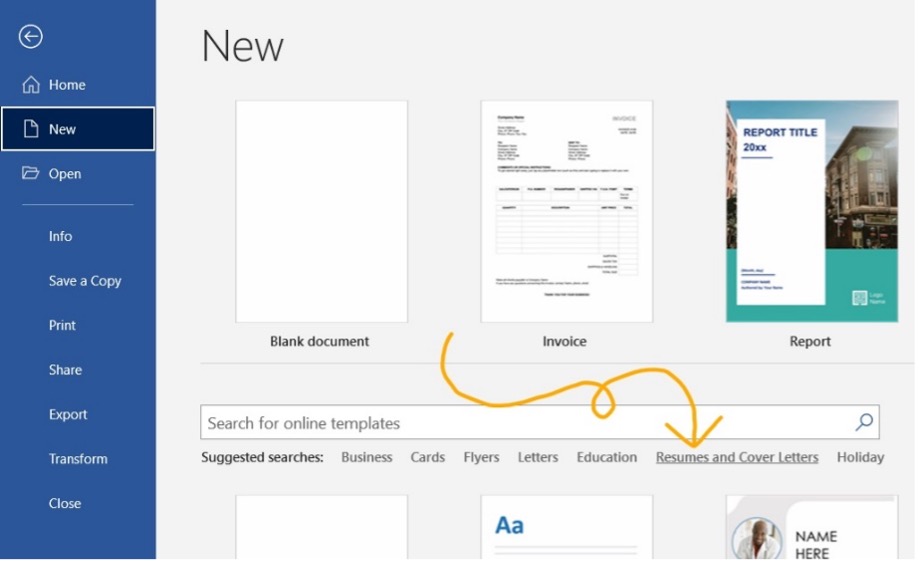
How Should I Format My Resume in Microsoft Word?
The format you choose will depend on your experience level!
There are 3 basic resume formats to choose between:
- Reverse-Chronological: Details your most recent job and works backwards from there. This format focuses heavily on work experience.
- Functional: Focuses on skills and education rather than work experience. This is a good option for recent graduates or applicants with minimal work experience.
- Hybrid/Combination: Combines elements of both the Reverse-Chronological and the Functional. This is a good option for applicants with gaps in their employment history.
Choosing the best format for your needs is key. For more help on this subject, check out our guide on How to Choose the Correct Resume Format in 2024 !
Beautiful resume templates to land your dream job

Make a Resume in Microsoft Word in 7 Easy Steps
First, let’s make sure you can navigate the Microsoft Word ribbon!
The ribbon is the toolbar found at the top of the screen.
It should look something like this:

The main parts of the ribbon you should familiarize yourself with on the Home tab are Font , Paragraph , and Styles .
These are how you will edit the appearance of your text and headers.
You should also familiarize yourself with the Layout tab .
This tab is where you will adjust your margins and add columns!
Once you have taken your time to figure out where all of your tools are, it’s time to begin building your resume!
Important Note: These steps detail how to create a resume in Microsoft Word from scratch. By using one of the program’s pre-made templates, you can bypass many of these steps and simply fill in the pre-made format.
Step 1: Create Your Layout
Let’s begin by visiting the Layout tab .
Here, you can set your margin size and decide if you want to use columns.
Here is a breakdown of these two elements:
We recommend using 1-inch margins on all sides.
This will give you enough white space to keep your resume looking neat without sacrificing too much space.
It will also ensure your formatting looks good on printed versions of your resume.
Columns and Sidebars:
From the columns tab, you will find five options:

- The One , Two , and Three options are how you will create separate columns.
- The Left and Right options are how you will create sidebars! Sidebars are useful because they leave more room for the main text and sections.
From the Home tab , you can edit the following elements of your layout:
Alignment:
Choose between left, center, or right alignment.
We recommend using the left alignment.
Whichever you choose, it is a good idea to keep your alignment consistent across the board.
Line Spacing:
We recommend using 1.15 – 1.5 line spacing for the body text.
For section titles and headers, use 1.5 – 2.0 spacing to help them stand out from the rest of the text.
Use a simple and highly legible font. Try to use only 1-2 fonts throughout your resume.
We recommend the following seven fonts:
- Times New Roman
Step 2: Make Your Title Header
Your title header should contain the following information:
- Your Job Title
- Contact Information
- Professional Social Media Links
Use an H1 header to write your name at the very top.
Use the Normal style to write the rest of your information (see “How Do I Add Different Sections of the Resume on Microsoft Word” below for more information on header styles).
It should come out looking similar to this:
Copywriter Email: [email protected] Phone: (123) 456-7890 Website: Janesmith.com LinkedIn: linkedin.com/in/janesmith
Check out some of our free resume examples to see alternative ways of formatting your title header!
Step 3: Write an Objective or Summary
Following your title header will be your resume objective or summary.
This will be a short statement between 1-5 sentences detailing your desired job title, experience, and career goals.
You will want to write this statement in the Normal style .
However, you may want to use a slightly larger font than the rest of the text in other sections.
This will help your objective or summary statement to stand out.
Here is an example of how this might look with the title header example from before:
Resume Objective: I am a copywriter with over 5 years of experience. working with corporate clients. I am seeking the position of Head Copywriter at your company, bringing with me over 10 major corporate clients.
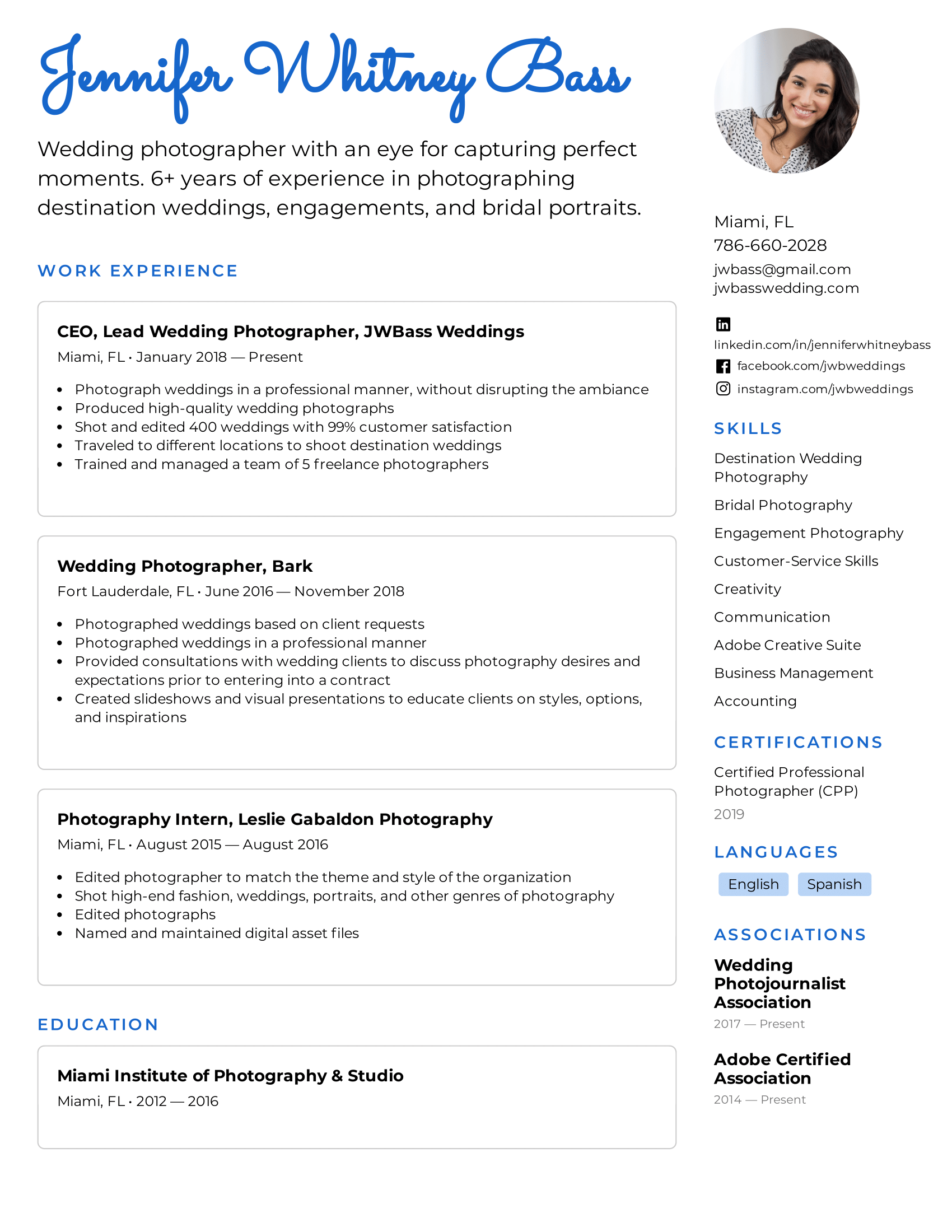
Step 4: Create Your Base Format
By creating a base format, you can save the document as a separate file to return to and fill in again and again.
This will help you to tailor your resume to fit specific jobs!
The idea of the base format is to provide outlined sections with the correct spacing and number of bullet points.
You are essentially creating a skeleton for your resume that you can edit and adjust over time.
By doing so, you ensure you have already allocated the proper amount of space on the resume for each section.
For example, this is what your base Work Experience section may look like:
Work Experience
Job Title 1 , Company Name Date – Date · Descriptive Sentence · Descriptive Sentence · Descriptive Sentence Job Title 2 , Company Name Date – Date · Descriptive Sentence · Descriptive Sentence · Descriptive Sentence Job Title 3 , Company Name Date – Date · Descriptive Sentence · Descriptive Sentence · Descriptive Sentence
As you gain more work experience, you can return to this base format and make changes as need be.
Because you have already outlined the section, you won’t have to worry about reformatting the entire resume to make a few simple changes.
Step 5: Determine Your Section Organization
Once you have built the base format of your resume, it’s time to determine if your sections are in the optimal location.
For instance, if you are creating a Reverse-Chronological style resume you will want your Work Experience section to come first.
Comparatively, if you are creating a Functional style resume you may want your Skills or Education section to come first.
The order and organization of your sections will impact the impression your resume makes on hiring managers.
Step 6: Fill in the Information
Now that you have created the base format of your resume and chosen the optimal organization, it’s time to fill in your information!
When filling in your information, be mindful of the following 3 factors:
- Be Concise: Always use simple sentences that clearly describe your strengths and accomplishments. Avoid complex sentences or overly complicated vocabulary and jargon.
- Use Bullet-Points: In each section, use bullet points to separate each thought or idea. This will make your resume more visually appealing and easier to read.
- Choose Compelling Language: Try to avoid repeating the same words or phrases over and over. Mix it up, use keywords, and find the best action verbs to make your resume sound even better!
Not sure how to make your language more compelling on your resume? Take a look at our list of 350+ Action Verbs to Make Your Resume More Effective in 2024 .
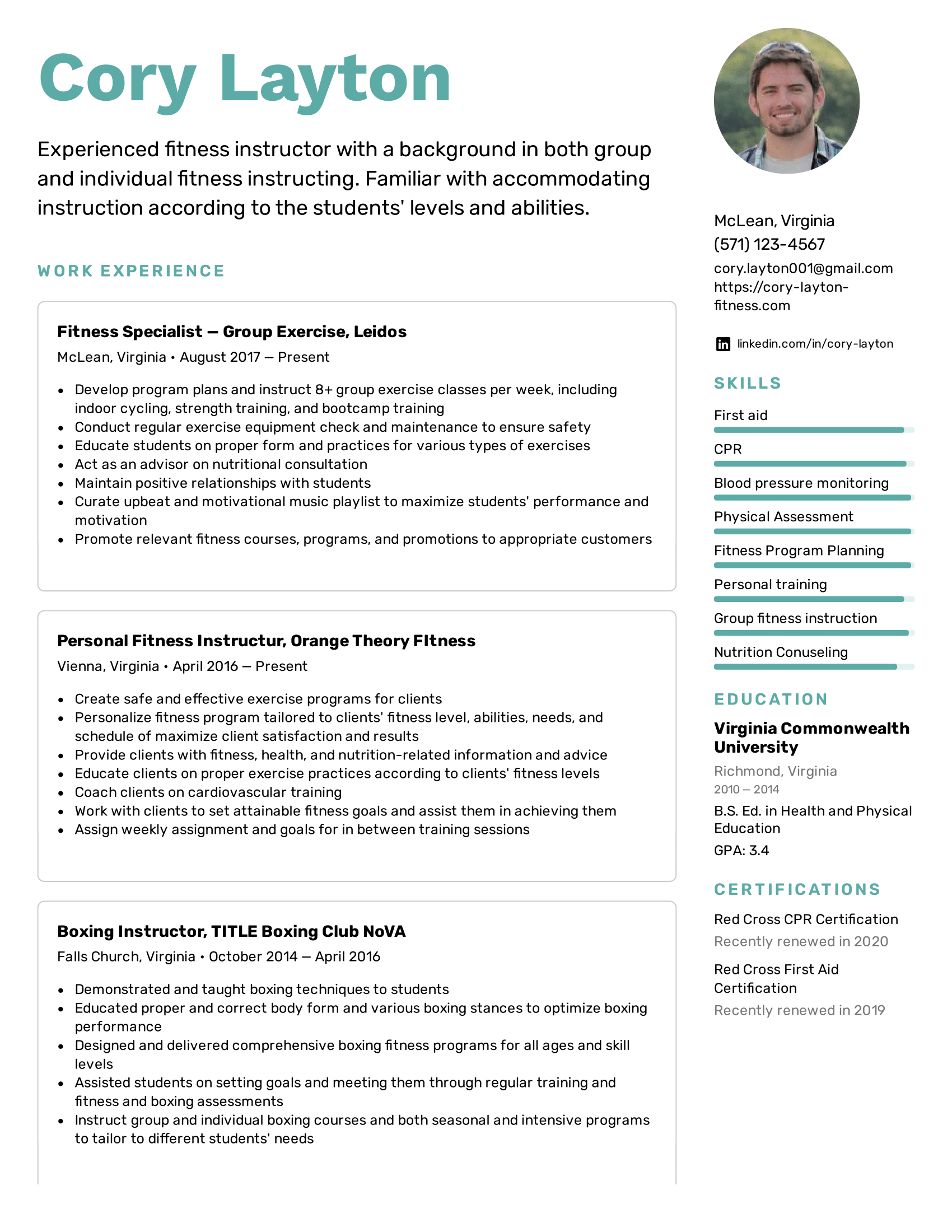
Step 7: Double-Check Your Sections
Once you have completed steps 1-6, look back over your resume and make sure you have included all of the key sections.
You should also take some time to consider what additional sections you could include.
Here are the key sections every resume should have:
- A title header with your name and contact information
- An objective or summary statement
- Work experience
As we have covered, the order of these sections will vary depending on the format you have chosen.
However, each of these sections should always be included in your resume.
There are also some additional sections to consider adding.
Here is a quick list of extra sections that can add some extra flair to your resume:
- Awards and achievements
- Certifications
- Unpaid experiences, such as volunteer work or internships
- Relevant hobbies
How Do I Add Different Sections to a Resume on Microsoft Word?
The way to create different sections on your resume comes in two parts:
- Use an H2 header to create the section titles (Work Experience, Education, Skills, etc.)
- Use the Normal style to create the body of text below the H2 header
Here is a breakdown of how to use the H1, H2, H3, and Normal styles within your resume:
Select the Styles window from the Home tab .
From here, you will have options to create headers.
Your heading options are as follows:
- Heading 1: Use this heading as your largest title. This is what you will use to write your name at the top of the page. Use a bolded font between 16 to 20 pt in size. Use 1.5 to 2.0 line spacing to help the title heading stand out.
- Heading 2: Use this heading to create your section titles. Use a bolded font size between 14 to 16 pt. in size. Make sure these headings are smaller than your title heading. Use 1.5 to 2.0 line spacing to help these headings stand out from the rest of the text.
- Heading 3: Use this heading to create your job titles. Your job titles should be only slightly bigger than the rest of the text. Use a bolded font between 12 to 14 pt. in size. Use between 1.15 to 1.5 line spacing.
- Normal: Use the Normal style to create the body text underneath the heading. Use a regular font between 11 – 12 pt. in size. Use between 1.15 to 1.5 line spacing.

What are the Pros and Cons of Using Microsoft Word to Craft Your Resume?
Microsoft Word is a handy tool to have, especially if your computer comes with the program pre-installed.
Here are 3 pros and 3 cons to using Microsoft Word to create your resume:
- Total Creative Control: When creating a resume on Microsoft Word directly from your computer, you have total control over the design and format.
- More ATS Friendly: Applicant Tracking Systems are designed to read .doc files, the file format used by Microsoft Word.
- Can be Edited by Recruiters: If you are using a recruitment agency, a Microsoft Word file can be easy to edit by recruiters before sending it off to employers.
- The Microsoft Word Learning Curve: If you are unfamiliar with Microsoft Word, there can be a pretty steep learning curve that can cause you frustration.
- Time Consuming: Building a resume from scratch can be highly beneficial, but also highly time-consuming. This can become problematic if you need to create a resume quickly.
- Temperamental Templates: Microsoft Word offers tons of free resume templates. On the surface, this is super useful. However, these templates can be tricky to use. One wrong move can mess up the formatting in a big way and be an even bigger headache to try and fix.
Why Should I Use an Online Resume Template or Resume Builder?
By using a resume template from an online provider, such as Easy Resume, you are more likely to find a template that fits your exact needs.
Plus, online resume templates and resume builders often have more design elements that are easier to use compared to Microsoft Word.
Are you interested in using our online templates or resume builder? Check out our beautifully designed resume templates to build your optimal resume!
Final Takeaways
Microsoft Word offers a lot of capabilities to help you build your ideal resume.
Here are five key takeaways for creating a resume on the program:
- Create a base skeleton for your resume that you can use again and again for different jobs.
- Use different heading styles to help your resume title and section titles to stand out.
- Use the column tool under the Layout tab to create sidebars. Sidebars are great for smaller sections, such as certifications or awards!
- Always use concise and compelling language.
- Consider using a template to build your resume faster.
At Easy Resume, we have designed our resume templates and online resume builder to fit your needs. No matter your level of experience or skill at making resumes, we have the tools to help.
Don’t forget to check out our expansive collection of FREE resume guides and examples while you’re here!
Browse more resume templates that fit your role

Ed is a co-founder of Easy Resume. His background in scaling teams at tech startups over the last decade has given him extensive experience and knowledge around how to hire top talent and build successful teams. He enjoys mentoring, coaching, and helping others reach their career goals. When he's not writing about career-related advice, he's playing with his dog, Lilo, or going on long hikes in upstate New York.
Get inspired with more resume examples
More advice that will accelerate your career path, 15+ key healthcare skills to list on your resume in 2024 (with examples).
Healthcare is a massive and important industry that contains all sorts of professionals. To land a job in healthcare, you must understand what relevant skills employers are searching for. In this guide, we will cover key healthcare skills to include on your resume and why doing so is so important.
15+ IT Skills to List on Your Resume in 2024 (With Examples)
IT is a massively growing industry with tons of potential for professional growth. It’s no wonder why so many applicants are flocking to these jobs! In this guide, we will cover what IT skills are and offer you examples of some of the top skills to include on your resume.
50+ Key Technical Skills to List on Your Resume in 2024 (With Examples)
Including technical skills on a resume is an absolute necessity. These types of skills show employers your quantifiable qualifications. In this guide, we will cover exactly what a technical skill is and some of the best examples to include on a resume.
20+ Key Computer Skills to List on Your Resume in 2024 (With Examples)
With the world becoming more digitally focused, having strong computer skills is more important than ever. In this guide, we will cover what computer skills are and which ones are best to include on your resume.
Read our how-to guides on making your resume perfect
How to write a resume header.
Your resume header is the very first thing an employer will see. Not only does it need to contain the correct information, but it needs to stand out as well! In this guide, we will teach you how to write the ideal header for your resume.
How to Write Your Resume in Reverse-Chronological Order
When setting out to write the perfect resume, choosing a format is an important decision. Reverse-chronological resumes are the standard format, so knowing how to craft one is key! This guide will teach you how to write the best reverse chronological resumes.
How to List Contact Information on Your Resume in 2024
Learn how to format contact information on your resume and what information to share with the hiring manager.
How to Write a Two-Page Resume (with Examples & Tips)
Don't know whether you should write a one-page or two-page resume? Find out when it is appropriate to write a two-page resume and learn how to write it correctly.
Professional resume templates to help land your next dream job.

Facebook • Twitter • Linkedin • Pinterest • Crunchbase
How-To Geek
How to create a professional résumé in microsoft word.

Your changes have been saved
Email Is sent
Please verify your email address.
You’ve reached your account maximum for followed topics.
Retro Consoles Look Bad on Modern TVs, Here's Why and How to Fix It
7 gadgets every digital nomad should know about, how does google's find my device work and is it secure, quick links, what is a résumé, using a microsoft word résumé template, crafting a custom résumé in microsoft word, deciding what information to include, organizing that information.
Pressing the send button when sending your résumé to a potential employer can be a nerve-racking experience. We're here to show you how to create a résumé using Microsoft Word and provide a few tips on getting you through the résumé screening process so you can press that send button with confidence.
A résumé, often referred to as a CV (curriculum vitae), is a summary of a person's background and experience, including work experience, education, and even volunteer work, and its most common use is to send to potential employers when searching for a new career opportunity. In fact, though taking on a much different form than that of what you'd expect a résumé to look like today, Leonardo Da Vinci even did this himself, and he is often given credit as the first person to create a resume.
Of course, the résumé has undergone quite the transformation since Da Vinci's 1482 version, drastically so during the age of word processors and digital typesetting in the 1970's---40 years after résumés became an institution. Fast-forward to today and not only do you have your standard .doc or .pdf résumé, but you'll also see people uploading video résumés on YouTube and using social media platforms like LinkedIn to sell themselves to companies.
We should be thankful for these developments because now we can skip the quill and ink and jump straight into Microsoft Word.
Microsoft Word offers a bunch of résumé templates. Some are beautiful; some are not. We'll let you decide which style fits you best, but here's where you can find them.
Go ahead and open Word. As soon as you do, you'll be greeted with several different templates to choose from, ranging from a simple blank document, cover letters, résumés, or even seasonal event flyers. Click the "Resumes and Cover Letters" link under the search box to see only those types of templates.

Now, you'll see all the different resume styles Word has to offer. There are a lot of different styles and color schemes to choose one, so pick what feels right. If you scroll down the list a bit, you'll also see some plainer resume templates designed for different purposes---like an entry-level, chronological, or extended CV style.
Some of the templates are already built into Word; others are a quick, free download from Office.com (and you won't even have to leave Word to grab them). When you click to create a resume, Word will let you know the download size (if it needs to download the template). Click the "Create" button and a few seconds later, you'll be in your document and ready to edit.
That's all there is to it! But what if you didn't find a résumé you liked? Luckily, Word has a few formatting tools to help you craft the perfect résumé.
Before we start, it's important to know that each résumé should reflect a person's personal experience and education. Since everyone's experience is different, it's no surprise that their résumés will be too.
That being said, there are some general aesthetic guidelines for making a résumé that we highly recommend you follow for a professional-looking document .
Go ahead and open up a clean, blank document in Word.
The first thing we'll want to do is set our margins. Go to the "Layout" tab and click the "Margins" buttons.

The drop-down menu displays several different margin options from which to choose. If you can't find the one you're looking for, you can click "Custom Margins" at the bottom and enter your specifications. Let's go ahead and do that.
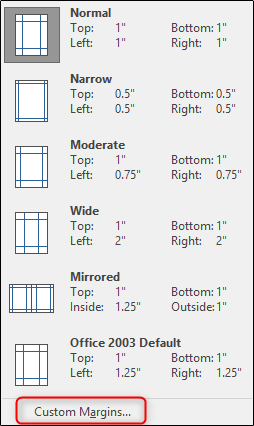
According to the experts, the best margin size is 1" for the top and bottom and 0.63" for the sides. This may seem like an oddly specific number, but the objective is to get as much (relevant) information about yourself as possible on a page without overwhelming the reader. With the above credentials, we leave enough white space on the page for the reader to not feel suffocated.
Click "OK" once you've entered the margin sizes you want.
Now that our margins are set, it's time to start inputting information.
The information you put mainly depends on what you're trying to accomplish and where you are in your professional career. If you have over two years of working experience, then detailing that information is much more valuable than which high school you graduated from or which clubs you were a part of in college. Like a cover letter, your résumé should uniquely cater to the recipient. Dress to impress.
So, which information should you put? We'll give you the overview, and you can decide which areas you should detail.
- Contact Information
- Professional Experience (It's also ok to include any volunteer work at the bottom of this section)
- Additional Skills
For all of these, tailor the information to the job. You don't need to fit irrelevant work experience in there unless not including it would create a gap in your work experience. But if you're applying for a job as an accountant, nobody cares that you delivered pizzas 12 years ago. And you do list out any additional skills, make sure they're relevant to the position for which you're applying. Your high school friend might be impressed by how high you can kick, but your future employer---not so much.
Another thing to remember is that you should always list out your experience in reverse chronological order. That is, list out your most recent experience first, and go back from there.
There're several ways to do this, but arguably the most effective way is by creating headings and then inserting a table for the content of each section. By doing so, you're not only able to move content around in groups instead of individually, which can be a headache in itself, but you're also able to give your résumé a unique touch by adding table designs. In the image below, for example, we've added a dashed border to the left side of the table to create a nice little visual element to tie the different experience elements together.
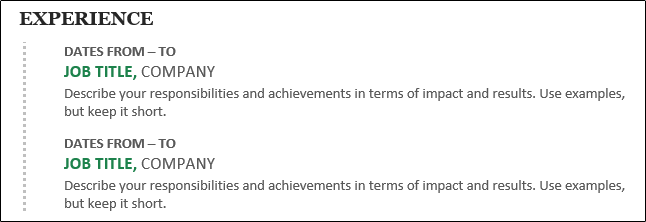
First things first, let's go ahead and find a heading that we like. In the "Styles" section of the "Home" tab, you'll find several default styles. If you can't find one you like, then Word has a feature that lets you create your own. First, click the "More" arrow on the right-hand side of the different built-in styles.
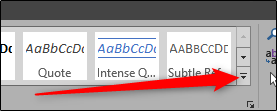
You'll see a menu with three different options. Go ahead and click "Create a Style."

The "Create New Style from Formatting" window will appear. The only thing you can do here is to name the style, so click "Modify."
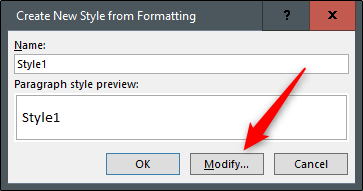
Now you should see a window with many formatting options. For fonts, there's no best option. Just make sure you use something that's clean and readable. "Georgia" is a great example. A 14 pt font size is fine for headings, but make sure it's bold so that each section is easier to find for the reader.
The "Add to the Styles gallery" option will automatically be selected. It's good to leave this option selected so you'll have easy access to your heading for the other sections of your résumé. If you plan to use this heading again in future documents, you can go ahead and deselect "Only in this document," but since we only plan to use it for our résumé, we'll keep that option selected.
Click "OK."
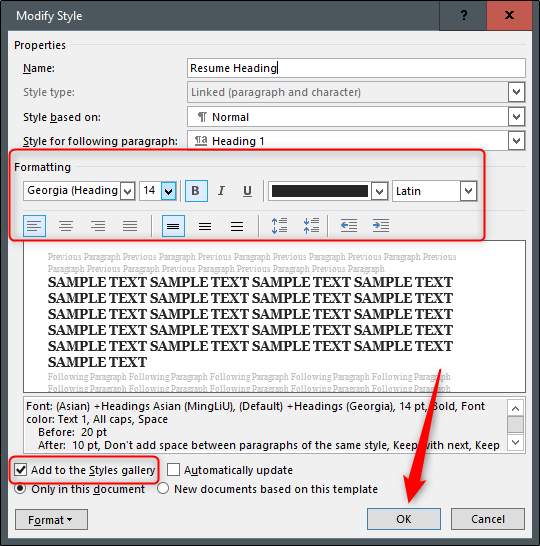
Go ahead and type in your first heading and apply the new style to it. In this example, we'll use "Experience" first.
Now, let's use a table under our first heading so that we can keep all our content lined up correctly. Place your insertion point on the line under your new heading, switch to the "Insert" tab, and click the "Table" button.
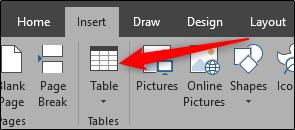
You'll see a 10x8 grid on the drop-down menu. You can create the table size by moving your mouse over the grid and clicking when it's the size you want. For your résumé, you'll need one column and enough rows to contain the separate pieces of information you have to list. For example, if you have three prior jobs to list in the Experience section, you'll want a table that's 1x3.
And here's what it looks like after we've inserted the table into the document.
We'll remove the border lines later. First, go ahead and put in your information. You'll want the "Job Title, Company" text to be 1 or 2 pts larger than the rest of the text but be sure to keep it smaller than the heading of the section. If you want your job title to stand out, you can change the color or make it italic, but try to keep it simple.
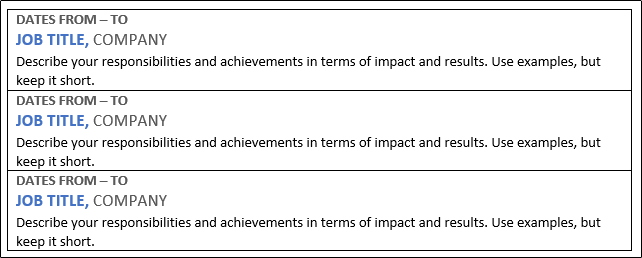
Once that's ready, let's go ahead change the borders of our table. Select the table by placing your insertion point anywhere inside it. Switch to the "Design" tab in the "Table Tools" section of the Ribbon, and then click the "Borders" button.
If you want to keep it simple and remove all the lines of your table, select "No Border." In this example, we're going to give our table a little flavor, so we'll select "Borders and Shading."
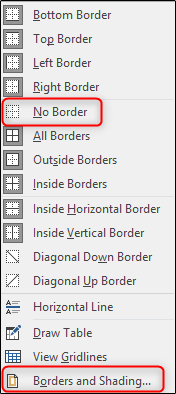
Because we only want to customize the left border of our table, we will select "Custom" under the "Setting" section. This lets us use the "Preview" section to deselect the sides on which we don't want borders. Click the boxes surrounding the preview to turn off all the borders except for the left one.
In the "Style" list, you can select the border design, color, and width you want. Click "OK" when you're ready.
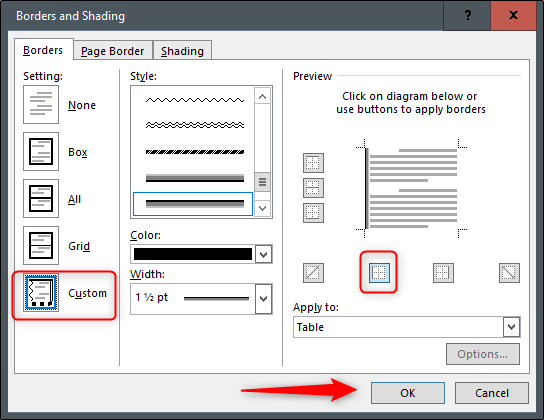
Now we should have an experience section on our résumé that's starting to shape up. A little playing with colors and maybe spacing the table rows a bit, and you should be ready to go.
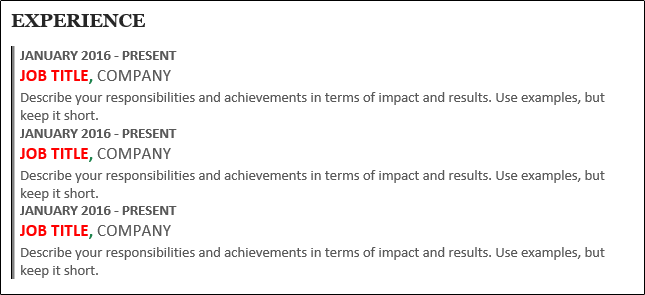
Now, just repeat these steps for the rest of the sections and your professional résumé will be finished in no time!
Image Credit: fizkes /Shutterstock
- Microsoft Office
- Microsoft Word
How to Make a Word Resume in 2024 - 7 Easy Steps

At some point or another - meaning, before online resume builders made our lives easier - most of us have had to make a resume in Word.
Now, making a resume in Word can be tiresome. Not being entirely optimized for the task, it can give you a hard time formatting and styling your resume to your needs - and this is just one of its disadvantages.
That being said, the use of Word is unlikely to drop only because it’s impractical. This means that knowing how to make a resume in Word is still a good skill to have. And if you’re sitting and thinking: “well, this doesn’t make matters any easier” - we hear you.
That’s exactly why this article is here - to teach you how to make a resume in Word, in just a few easy steps.
- Should You Make a Resume in Word?
- How to Make a Resume in Word in 7 Easy Steps
- How to Format your Resume - 3 Pro Formatting Tips
But before we dive into the nitty-gritty details of how to make a resume in Word, let’s go through the downsides of using it to build your resume, and what other easier alternatives you might have in more detail.
Should You Make a Resume in Word?
Microsoft Word might once have been a top resume-building option, but that time is long gone. Although it has ready-made templates, Word in itself was never meant to be a resume builder - this reflects on the end product, which often looks old-fashioned and dull.
Not to mention that it offers very little space for creativity. Try to make a small change in the layout and see the format crumble in front of your eyes.
On the other hand, if you simply use the Word template without customizing it, yours might just become another resume in the crowd that won’t even pass the Applicant Tracking System (ATS) - the software most companies use to filter through countless resumes they receive daily.
Long story short, here are MS Word’s main cons as a resume builder:
Long story short, here are MS Word’s main cons as a resume builder:
- It can be clunky and outdated - chances are, any Word template you choose to use for your resume will look old-fashioned. Technology has changed what is expected of your resume, just as it has changed job-search over the last decade.
- It is not ATS-optimized - the software that most recruiters use not to waste time looking at the resumes? Well, most Word templates are not optimized for it. This means that you can be the fittest candidate for the job and not even get invited to an interview.
- It’s time-consuming - making changes to the layout of a Word resume template is a nightmare.
Everyone knows what happens when you move an image in Word:
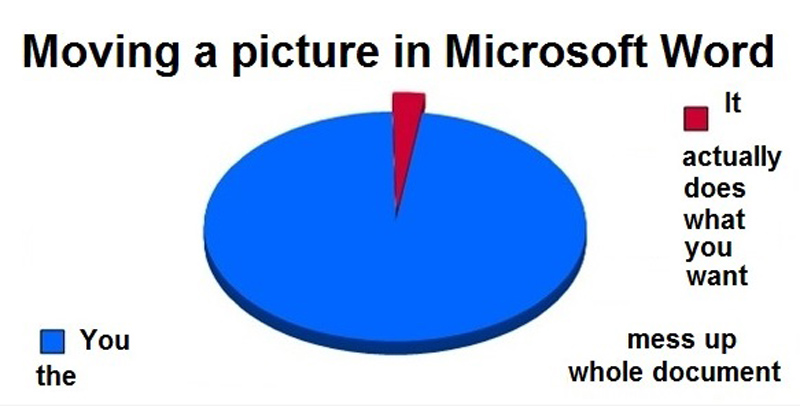
It’s exactly for these reasons, as well as the added efficiency, originality, and time preservation, that online resume builders are the obvious choice for creating your resume.
Novorésumé’s online resume builder is fast, easy to use, and perfect if you want to land that interview. You can start building your resume immediately just by clicking on the link, or you can pick one of our free resume templates , according to your needs.
Step #1: Pick a Word Resume Template
The first step in making a resume in Word is accessing its free resume templates. How you access the templates may change depending on the Microsoft Word version you’re using, but what you ultimately need to do is the following:
Open Word.
Select one of the Resume templates Word suggests, or simply search for “resume” and you’ll find a bunch more.
Choose the resume template that best fits your qualifications and professional profile.
Click “Create.”
You’re good to go: the template should appear as a Word document ready to be filled with your personal information and all other relevant sections.
Step #2: Create a Resume Header
From this point on, things should be pretty easy to pick up.
Start filling up your resume from the top, which is where the resume header is located. Traditionally, the header should include the following information:
- First and last name
- Phone Number
- Location (Street Address, City, State)
You may notice the lack of optional information in this resume template, such as your professional job title , your LinkedIn URL , or social media links.
If you feel like that info will significantly improve your resume, look for a Word template that includes them, or manually add them to the template you’ve already chosen. We’ll go over some formatting techniques to improve your resume template later on in the article.
Step #3. Include a Resume Summary or Objective
Next, you need to describe your professional experience or professional goals (in case you lack the experience) through the resume summary or objective.
Write a resume summary or resume objective - depending on which one best fits your resume - and try to express yourself in a way that will keep the recruiter’s attention for more than the traditional 7 seconds .
Quick recap: a resume summary is a 2-3 sentence overview of your career and is used in 90% of the cases. A resume objective is more commonly used among those with little professional experience or those who are changing careers and describes your professional goals.
Step #4: Create a Compelling Work Experience Section
This is where things get serious.
The work experience section is the most important part of your resume for obvious reasons and usually plays a decisive part in the recruiters’ decisions. So just filling up the gaps in the experience section of the Word template won’t be enough. You should try to make this section as compelling as possible - following some of the tips provided below.
But first, the basics. As with any standard format, the experience section should include the following components:
- Job title and position
- Company name and location
- Dates of employment
- Achievements and responsibilities
Again, how the resume looks in Word will depend on the template that you have chosen.
Obviously, the template lets you add as many professional entries as you wish - but that doesn’t mean you should go overboard. List your experience in reverse-chronological order, meaning: start from the latest and move back in time, based on the amount of professional experience you possess.
There are, of course, a couple of pro tips that you should follow even as you use the Word templates to make your experience section more compelling.
Pro Tip #1 - List achievements over responsibilities
Notice the example above.
Instead of responsibilities, we have opted to list achievements. Listing achievements over responsibilities whenever possible is one of the best ways to stand out in the eyes of recruiters. That’s because responsibilities are similar for one type of job, while achievements show exactly what you can contribute to the position .
Pro Tip #2 - Tailor your resume to the job you are applying for.
Another good practice is tailoring your resume to the job you are applying for. This can help you go through the ATS and land your resume right on the recruiters’ tables.
If you want to know exactly what information to include in your resume, how and when to list achievements over responsibilities, and how to tailor your resume to your job, head over to our complete guide on how to write a resume .
Step #5: Add Your Educational Background
Things should get quite easy after you get your professional experience section out of the way.
The education section of your resume should include the following:
- University name and location
- Years attended
- Program name / Degree obtained
Optionally, you can include your GPA, Minor degrees, or any special award or academic achievement. Our advice is to include them only if you are a recent graduate or entry-level professional with not much else to include in your resume, or if your education history is truly outstanding.
Step #6: Make Sure to Include Your Skills
At this point, you can consider most of the work done!
Now that you have reached the skills section, things get even easier. Make a bullet or numbered list of your hard and soft skills and you’re good to go.
Hard skills are usually measured through experience levels - you can place your experience level (usually categorized into Beginner/Intermediate/Advanced or Expert ) into brackets, so you don’t take up too much space within the resume.
Pro Tip #3 - Tailor the skills and qualifications on your resume to the job
Take a look at the essential skills required on the job ad and see if you can incorporate them into your list of skills.
Step #7: Include Optional Resume Sections
Congrats - you can finally stretch your legs and even allow yourself a little pat on the back.
The additional sections are not mandatory in a resume, so if you’ve reached your resume space limit, you can just call it a day and save your resume.
They are, however, a great way to show off additional assets such as languages, hobbies and interests, and even volunteering experience on your resume !
- Remember to also determine your language knowledge levels. Those are Native , Fluent , Proficient , Intermediate , and Basic.
In the off chance that you still have some space left - considering resumes should be 1-2 pages at most and that Word templates are not as good at saving space as online resume builders - you can include the following optional sections:
- Certifications and Awards
- Publications
Follow the same practice as with the skills section, and you’re good to go!
How to Format Your Word Resume
With all the essentials covered, let’s go over some formatting tips such as fonts, line spacing, and headings so that your Word resume looks as uniform and clean-cut as possible.
Best Resume Fonts in Word
We cannot repeat this enough - the resume font you use, matters. It matters just as much as first appearances matter and we all know they do, a lot.
The font that you decide to use will impact your resume readability whether you like it or not, so you should use a font that will help you stand out, but not in a bad way. What’s a bad way? Comic Sans and other similarly-looking comic fonts.
The usual Times New Roman, point-12, formula, on the other hand, will just blend you with the crowd.
Instead, consider using one of the following recruiter-friendly fonts which will complement your resume both on-screen and in printed form, according to Business News Daily :
- Book Antiqua
- Trebuchet MS
Optimal Line Spacing for a Word Resume
The good thing about the Word resume template is that it usually has fonts and line spacing covered for you, yet it’s still good to know that the best line spacing for resumes is 1 or 1.15 between text and double lines after headings.
Feel free, however, to play around with line spacing when it comes to adjusting your resume layout.
Headings in a Word Resume
Again, Word templates do a good job of making the headings stand out. As a rule of thumb - and as is noticeable in the above examples - headings should be bigger than the rest of the text. So, if you’re using a 12 pt text, consider adjusting the headings between 14-16 pt.
You can also underline or bold each resume section heading, or even use a different font, but as we always advise: don’t go overboard and try to maintain the style of the Word resume template that you have chosen.
And by now, you should have a complete resume in Word that looks like this:
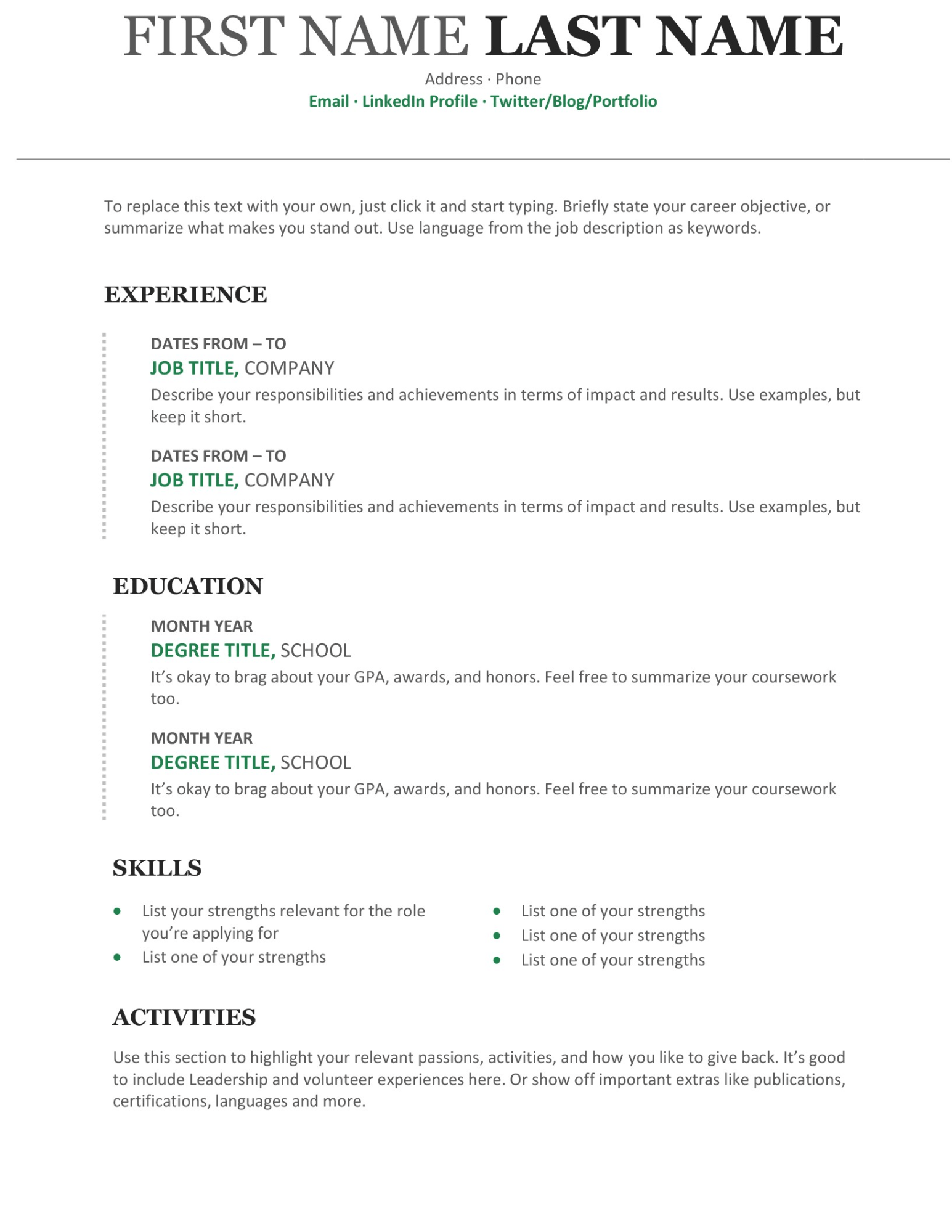
Key Takeaways
Well, here you have it - your nicely tailored resume in Word, ready to land you that job interview.
Although not the easiest task, we are convinced this article has given you all the necessary information on how to make a resume in Word and the confidence to do so easily.
Here’s what’s good to remember:
- Order your resume sections properly, usually in reverse-chronological order.
- Make sure that your section headings stand out from the rest of the text, by usually using a larger font size.
- Check if your chosen font, line spacing, and margins are aligned, readable, and professional-looking.
- Opt for an online resume builder such as the one Novorésumé provides for a more modern, time-saving, and HR-friendly resume.

To provide a safer experience, the best content and great communication, we use cookies. Learn how we use them for non-authenticated users.
- PRO Courses Guides New Tech Help Pro Expert Videos About wikiHow Pro Upgrade Sign In
- EDIT Edit this Article
- EXPLORE Tech Help Pro About Us Random Article Quizzes Request a New Article Community Dashboard This Or That Game Popular Categories Arts and Entertainment Artwork Books Movies Computers and Electronics Computers Phone Skills Technology Hacks Health Men's Health Mental Health Women's Health Relationships Dating Love Relationship Issues Hobbies and Crafts Crafts Drawing Games Education & Communication Communication Skills Personal Development Studying Personal Care and Style Fashion Hair Care Personal Hygiene Youth Personal Care School Stuff Dating All Categories Arts and Entertainment Finance and Business Home and Garden Relationship Quizzes Cars & Other Vehicles Food and Entertaining Personal Care and Style Sports and Fitness Computers and Electronics Health Pets and Animals Travel Education & Communication Hobbies and Crafts Philosophy and Religion Work World Family Life Holidays and Traditions Relationships Youth
- Browse Articles
- Learn Something New
- Quizzes Hot
- This Or That Game
- Train Your Brain
- Explore More
- Support wikiHow
- About wikiHow
- Log in / Sign up
- Job Application Documents
- Resume Preparation
How to Create a Resume in Microsoft Word
Last Updated: September 25, 2023 Approved
This article was co-authored by Alyson Garrido, PCC . Alyson Garrido is an International Coach Federation accredited Professional Certified Coach (PCC), Facilitator, and Speaker. Using a strengths-based approach, she supports her clients with job search and career advancement. Alyson provides coaching for career direction, interview preparation, salary negotiation, and performance reviews as well as customized communication and leadership strategies. She is a Founding Partner of the Systemic Coach Academy of New Zealand. wikiHow marks an article as reader-approved once it receives enough positive feedback. In this case, several readers have written to tell us that this article was helpful to them, earning it our reader-approved status. This article has been viewed 1,636,222 times.
Resumes detail a person’s work experience, education, skills and achievements. A good resume that is clear, concise and easy to read is essential when looking for a job. Resumes should be word processed and should be neat and tidy. Microsoft Word offers you the option of creating your resume through templates, but you can also create your resume from scratch using Word's formatting features.
Sample Resumes

Creating a Resume from a Template (Word 2003, 2007, 2010, 2013)

- In Word 2007 you will have to click on “installed templates.”
- In Word 2010 it will be “sample templates.”
- In Word 2011 it will be “new from template.” [1] X Research source
- In Word 2013 the templates will be displayed when you click on “New.”

- In Word 2013, after clicking on “New” you will see a number of templates and a search bar which says “search for online templates.”
- After searching you will see a number of different resume templates to try out.

- Here you will be able to look through a number of templates for resumes and cover letters that you can download for free and edit in Word.
- You may have to sign in with your Microsoft online account to use these templates. [2] X Research source

- Be sure to look carefully at the detail of your resume and proofread it thoroughly.
- All of the versions of Word from 2003 to 2013 all come with some pre-installed templates for resumes.

- Click on the “Other Documents” tab, and then select “Resume Wizard.”
- Follow the wizard's instructions. The wizard will walk you through the resume creation process step-by-step
- If you do not see this option, it was not installed when you installed Word, and you will need to run the installation program again to install it.
Creating a Resume Without a Template

- Education and qualifications.
- Work and volunteer experience.
- Skills and qualities.
- It should also include your full contact details and state that references are available upon request.

- Most chronological resumes only cover the last 5 to 10 years of your employment history.
- You may wish to include positions earlier than this if they are appropriate to the job you're seeking.
- This is the format most American employers prefer to see resumes in.

- A combination resume might list your key skills at the top before providing a short account of your experiences.
- This type of resume can be helpful for those entering the job market with little work experience, or for those trying to change careers. [6] X Research source

- The CV is commonly used when applying for positions in Europe, and also when applying for positions at colleges and universities worldwide.
- CVs can be thought of as living documents that records all your work and achievements, which will generally grow and develop over time more than a resume. [7] X Trustworthy Source University of North Carolina Writing Center UNC's on-campus and online instructional service that provides assistance to students, faculty, and others during the writing process Go to source
Writing Your Resume

- If your resume extends beyond one page, ensure that your name is in a header on every page.
- Your email address should appropriate for a job application. Use your own name or initials if possible.
- Don’t use something jokey such as "sly-dude," "foxymama," or "smokinhot."

- For example, you might write that your objective is “To contribute to the design of new word processing software.”
- Alternatively it may state the position you hope to attain, such as “A position as in healthcare policy and research.”
- Objectives have become less common, and you may prefer to provide this information in your covering letter . [8] X Research source

- You can include a bullet point or two to provide a little further information on your specialism, if it is appropriate for the position you are applying for.
- If you achieved any honours or awards as part of your studying or training include these here.

- Use bullet points to make sure it is clear and easy to read or scan through for key words relating to the position you are applying.
- You can include volunteer positions if they relate to the job you're seeking or if you have little paid experience. [9] X Research source

- You can title this section as “Other Relevant Skills”, or just “Skills.”
- This could include proficiency in foreign languages, knowledge of particular computer software and programmes, and any other specific skills not previously mentioned. [10] X Research source
- Take care to avoid repeating yourself. You don’t need to say you have “excellent communication skills” more than once.

- Allow reasonable margins around the edges of the page. Word's default settings are usually sufficient for this.
- Left-align your section headings. You can use single-spacing after a heading and before the section content, and double-spacing before a heading.
- Get your resume down to one page if at all possible. You can try adjusting your line spacing in the Paragraph dialog box, but don’t lose your neat formatting trying to get it down to one page.
- Rethink your words and try to express yourself more concisely.
Expert Q&A

- Don't wait until you're looking for work to update your resume. Any time you have a promotion or significant accomplishment, add the new information to your resume. Thanks Helpful 5 Not Helpful 1
- Always tailor your resume to the type of position you're seeking. You may have to add, rearrange, or delete accomplishments or entire sections according to what the position requires. Thanks Helpful 6 Not Helpful 2

- The appearance and format of your resume is a reflection of your competence; be sure it represents you at your best. Thanks Helpful 5 Not Helpful 1
- Be sure that all the statements in your resume are both factually and grammatically correct and that all words are spelled correctly. Thanks Helpful 4 Not Helpful 1
You Might Also Like

- ↑ https://kb.iu.edu/d/agst
- ↑ https://templates.office.com/en-us/Resumes-and-Cover-Letters
- ↑ http://cla.umn.edu/student-services-advising/career-internship-services/job-search-resources/resume-guide/formatting-0
- ↑ http://writingcenter.unc.edu/handouts/curricula-vitae-cvs-versus-resumes/
- ↑ http://www.career.cornell.edu/story/resumes/parts.cfm
About This Article

1. Open Word and click File . 2. Click New . 3. Click a resume template. 4. Type your own data into each field. 5. Save your resume as a new file. Did this summary help you? Yes No
- Send fan mail to authors
Reader Success Stories
Jan 19, 2017
Did this article help you?
Asrar Ahamed
May 16, 2020
Amisha Khatri
Nov 23, 2016
Jan 9, 2017
Aug 12, 2017

Featured Articles

Trending Articles

Watch Articles

- Terms of Use
- Privacy Policy
- Do Not Sell or Share My Info
- Not Selling Info
Get all the best how-tos!
Sign up for wikiHow's weekly email newsletter
Protect your data
This site uses cookies and related technologies for site operation, and analytics as described in our Privacy Policy . You may choose to consent to our use of these technologies, reject non-essential technologies, or further manage your preferences.
- Resume and Cover Letter
- Step-by-Step Guide on...
Step-by-Step Guide on Creating your Resume Using MS Word
9 min read · Updated on December 08, 2023

Microsoft Word is the best program to use when creating your resume. Here's how to do it so that your resume gets past the Applicant Tracking System - ATS and impresses hiring managers.
Microsoft Word comes with some very attractive templates that are ready to use and allow you to fill in the blanks. The bad thing is the templates offered by Word are not usually ATS-friendly. It is best to create your resume from scratch. You can do so without being an expert at using Word or knowing all of the formatting options the program offers.
A simple online search about creating a resume from scratch returns millions of results. Choosing the right set of instructions can be daunting. So, instead of going down that rabbit hole, follow this step-by-step guide on creating a resume using MS Word.
MS Word resume templates
It can seem like an easy answer to pick a template offered by Word. You open the program, click templates, and are presented with hundreds of options. However, considering that ATS can't properly parse information from resumes that have text boxes, columns, images, and charts, those templates are not going to serve you well .
Submitting a non-ATS-friendly resume is the best way to have your resume rejected for a job. When your resume is rejected by the ATS software, the human beings at the company don't even know you exist. It is one of the top reasons job seekers are ghosted by companies.
Format your overall document before you start typing
Believe it or not, an ATS will scan resumes for everything from keywords, experience, and education to margin width and font. There are some pre-typing formatting options you'll need to set to ensure that the ATS can read your document.
Set your margins so that they are no narrower than 0.5 inches all the way around. Alternatively, you can use 0.75 and one-inch margins if you prefer.
Choose the font you want to use . You can use more than one font in your resume to distinguish between headers and body text, but use no more than two separate fonts.
On the “Paragraph” formatting ribbon, set your line spacing to “Multiple” at 1.06 and enter “6 pt” in the “Before” box to ensure that your lines are squished together. You want to create some white space in your resume.
Setting the right formatting options ahead of time can save you some headaches when you're finished typing the text.
As you type out your resume information in your resume, use the “Font” and “Styles” formatting ribbons to customize things like font size, colors, headers, and section separators. Your resume should contain the following sections :
Other (e.g., Affiliations, Licenses, Certifications, Volunteerism)
Your contact section
Type your name on a line by itself. Typically, you want your name to be larger than the other text on the document. You can even put it in all caps or small caps to help it stand out. On the next line, type your city, state, zip code/postal code, phone, email, and any online portfolios you want hiring managers to know about.
It is no longer customary to include your full address. There have been instances of discrimination against job seekers based on their home addresses. It is critical, though, that you include your zip or postal code. Hiring managers can query the ATS for resumes within a radius of a zip code. If your zip code is missing, your resume doesn't get included.
If you use the “Intense Quote” style, your name and contact information will be set apart from the rest of the document with a border along the top and bottom of the text. Highlight your name to increase the size of the font and make it bold.
Title and summary section
As you write the title and summary of your resume, make sure that it is future-facing and targeted to the job to which you want to apply. Type the title on a line by itself and, like your name, put it in all caps, small caps, larger text, and bold text so that it stands out from the rest of the words on the page. It's also a good idea to center it on the line. You can also change the color.
Some rules to use when applying color to your resume:
Color draws attention to the important parts.
Use bright colors (e.g., blue and green) for headers and contact information.
Use complementary colors (e.g., lighter shades of blue and green) for subheadings, position titles, and degrees.
Avoid using red on your resume as red is associated with stopping. You don't want to give someone a queue to stop reading your document.
The summary paragraph should be three to five sentences in length with a focus on what you bring to the table in alignment with relevant keywords from the job description. Be specific, but be concise. Focus on how much experience you have, a few things that you're really good at, and include at least one achievement.
Your skills section
Your contact section, title, and professional summary won't have headers. The skills section is where you'll start including headers to separate content. Type the word “Skills” on a line by itself. Follow the same style for each of the other sections in your resume.
Then, on the next line list out your professionally relevant and job-specific skills. Keep the list to no more than 12 skills and be sure to use a strong mix of hard and soft skills .
Your professional experience section
This is where the bulk of your resume content should appear. In order to properly write your experience section, you should use the chronological resume format . This simply means that you start with your current or most recent job and work backward. There are some general rules of thumb to keep in mind when writing the experience section of your resume.
How to lay out the information for each job: Start with the name of the company and the timeframe you were employed there. It's best to use the MM/YYYY format for your jobs. After that, list your position title followed by three to five achievement bullets. Make sure that each bullet starts with a verb so that you have an action-based resume.
Stick to the last 10-15 years of experience: A great resume represents approximately 10 years of experience. It's okay to go back 15 years, but it's recommended that you avoid going further than that. You can certainly list older experiences under an “Early Career Experience” title, but the roles in that list won't contain bullets detailing your accomplishments.
Use stacking to list multiple roles at the same company: When you have progressed through more than one position within a single company, you'll list the company name first with the total amount of time you were employed there. In the next line, you'll list the last role you had with the company and the time you held that position followed by your achievement bullets. After those bullets, list the previous role you held with the company with the time you were in that role but don't list the company name again. Here's what that looks like:
ABC Company | 03/2007-Present
Senior Leader (05/2015-Present)
Experience that relates to the job to which you're applying.
Example(s) of projects or situations where you used this skill.
1 to 2 accomplishments or measurable results showing your expertise with this skill.
Associate Leader (03/2007-05/2015)
Your resume isn't meant to be a record of your professional life's events.
Talk about achievements that will intrigue a hiring manager to call you for an interview.
Anytime you can use numbers, it's best to do so.
Your education section
End your resume with an education section, which includes your education, professional development, and any credentials you may possess. List graduation dates only if you're still in school or graduated within the last year. You should also spell out acronyms (e.g., Master of Business Administration rather than MBA). You can put the acronyms in parentheses after the full spelling. This holds true for degrees and school names.
If you didn't graduate, you can still list your higher education on your resume. After you type out the degree you were pursuing and the name of the school, put verbiage that indicates the degree is unfinished. Here's an example:
Bachelor of Science in Business Management | ABC State School | Expected completion: MM/YYYY
When you didn't finish and know you're not going back, simply put the number of credit hours you completed in the place of the “Expected completion” text:
Bachelor of Science in Business Management | ABC State School | 98/120 Credit Hours Completed
Additional sections that may appear on your resume
Some jobs require you to be a member of a particular organization. You may have completed some career-related research or have articles published to which you want to call attention. Put a relevant header for any extra information that you want on your resume and type out the information.
Formatting headers
Now that you have the content written, it's time to make it look pretty. It's easy to update the text of each header title by enlarging the font and using bold. You can do more, though.
- Shading: Highlight the “Skills” header and click the down arrow next to the paint bucket icon on the “Paragraph” formatting bar. This will allow you to change the shading behind the header. Be sure to use something that complements any color you've already used and don't let the shading make it so you can't read the header text.
- Borders: With the word “Skills” still highlighted, click the down arrow next to the borders button on the “Paragraph” formatting bar (it's right next to the paint bucket icon). Choose to add a top or bottom border (or both) to your header. The choice is completely yours to use one or both borders.
Whatever formatting you decide to finish with on the “Skills” header needs to be repeated on all headers to ensure a level of consistency within your resume. The only header that wouldn't need formatting is the line you created if you decided to list “Early Career Experience.” You can simply bold that and leave it as simple text.
Now you have a beautifully formatted, from-scratch resume. In the end, all you needed to know how to do was bold text, change the font, and format shading and borders.
If you have questions, TopResume has a team of expert resume writers standing by.
Recommended reading:
- The Hidden Dangers of Using Microsoft Word Resume Templates
- What's an ATS-Friendly Resume? And How to Write One
- How to Write a Chronological Resume (Tips + Examples)
Related Articles:
Do Hiring Managers Actually Read Cover Letters?
How to Create a Resume With No Education
Why You Lose When You Lie on Your Resume: Learning From Mina Chang
See how your resume stacks up.
Career Advice Newsletter
Our experts gather the best career & resume tips weekly. Delivered weekly, always free.
Thanks! Career advice is on its way.
Share this article:
Let's stay in touch.
Subscribe today to get job tips and career advice that will come in handy.
Your information is secure. Please read our privacy policy for more information.

Try Process AI free
How to make a resume in microsoft word.
Beginning your job hunt can seem like a daunting task. Crafting a perfect resume, however, doesn’t have to be. Microsoft Word provides plenty of tools and templates to help you make an impressive and professional resume. Just a few simple steps and you can have a stand-out resume.
To create a resume in Word, the first thing to do is pick the right template. Word has loads of pre-designed templates especially for resumes. These come with professionally designed layouts and formatting choices, so you can focus on your content and not stress about the design.
Once you have the template, you can customize it with your own info. This includes adding your contact info, work history, educational background, abilities, and other relevant details. All you need to do is replace the placeholder text with your own.
Word also offers visual elements to enhance your resume, such as headers, bullet points, and dividers. This makes the text easier to read and more visually appealing.
Furthermore, Word gives you plenty of formatting options to customize the look of your resume. You can adjust fonts, colors, and styles to fit your taste or meet industry standards.
In short, creating a resume in Microsoft Word is not difficult. It helps you showcase your talents effectively. Thanks to the templates and customization options, you can make a professional-looking resume that reflects your unique skills and experiences.
Setting up Microsoft Word for resume creation
Setting up Microsoft Word for creating a resume
To effectively set up Microsoft Word for resume creation, follow these 5 steps:
- Open Microsoft Word and click on the “File” tab.
- Select “New” to open the template options.
- Type “resume” in the search bar to access various resume templates.
- Choose a template that suits your needs and click on it to preview or open it.
- Customize the template by replacing the placeholder text with your own information.
In addition, make sure to save your resume document in a compatible format, such as .doc or .docx, to ensure easy sharing and compatibility with different devices.
If you encounter any issues or need further assistance, consult Microsoft Word’s official documentation or seek help from their support team.
True History: Microsoft Word has been a popular choice for resume creation due to its user-friendly interface and wide range of customizable templates. Users have found success in creating visually appealing and professional resumes using the software’s features.
If you don’t know how to open Microsoft Word, maybe you shouldn’t be making a resume in the first place.
Opening Microsoft Word
Open Microsoft Word and get ready to write your resume like a professional! Here’s a four-step guide to help you out:
- Start the app: Click the Start menu, type “Microsoft Word” in the search bar, and hit enter. Or find the Word icon on your desktop or taskbar and double-click it.
- Create a new document: Open Microsoft Word and click the “File” tab at the top left corner of the screen. Select “New” from the drop-down menu.
- Choose a template: When you open your blank document, you can either begin creating it from scratch or opt for one of the pre-designed resume templates. Look for the “Templates” option on the right side of the screen.
- Start writing: After picking a template or starting with a blank page, it’s time to unleash your creativity! Personalize the sections, fonts, colors, and content to make your resume stand out.
Don’t wait any longer – open Microsoft Word and get started! Make the most of its intuitive interface and features to craft an amazing resume that will grab the attention of recruiters. Your dream job could be just around the corner – so start writing now!
Selecting a resume template
Pick a template that matches your style and profession. A modern and clean one usually works. Creative fields need something more unique.
Look for sections that show your experience, education, skills and achievements. An organized layout is best.
Check that you can customize it with fonts, colors and sections. This helps adapt it to your needs.
Choose one with clear headings and enough white space. Avoid complicated designs and too many graphics.
Make sure it’s compatible with software like Microsoft Word.
Ask colleagues or professionals for feedback. Their advice can be useful.
Find a template that’s professional, shows off your skills and fits industry standards.
Take your time to explore different templates.
The right resume template will give you an edge over other candidates. So start searching today and take the plunge towards that dream job.
Customizing the resume template
Choose a professional font and formatting style; one that’s simple to read.
Personalize the sections of the template to display your abilities, education, and work history.
Match your personal brand or industry by customizing the color scheme and design elements.
Add or take away sections to make a comprehensive resume.
Little details can have huge effects. Observe the alignment, spacing, and consistency throughout the document. Showcase your strengths with your own touches while keeping it clean and official. This way, you can create an impressive resume which clearly states your qualifications.
Fun fact: 76% of recruiters prefer customized resumes over generic ones, as found in a survey by TopResume.
Adding personal information
Adding personal details in a resume
Starting with personal information for a resume, it is crucial to include relevant details in a professional manner. Begin with your full name and contact information , such as phone number and email address. Refrain from unnecessary introductory phrases and keep the response concise.
Next, mention your home address , making sure it is up-to-date. Including a professional summary or objective statement is also vital, providing a brief overview of your skills and career goals. Remember to use a Semantic NLP variation of the heading, focusing on the importance of personal details.
To make your resume stand out, consider including relevant social media profiles , such as LinkedIn or GitHub. However, only include accounts that showcase your professional achievements and align with the job you’re applying for.
Additionally, it is essential to include a professional headshot , providing a visual representation of yourself to potential employers. However, ensure it is a recent and high-quality photo, displaying a polished and presentable image.
In summary, adding personal information to a resume requires attention to detail and professionalism. Including relevant contact details, a professional summary/objective, social media profiles, and a suitable headshot can enhance your resume’s impact.
(Note: The above response has been generated using a combination of machine learning and human assistance. It may not be entirely accurate or represent the views of the authors.)
Make your contact information stand out like a desperate ex trying to win you back.
Contact information
Don’t miss out! Update your contact details today.
Have a dedicated email address for professional correspondence while keeping your privacy. Including a reliable phone number makes communication and accessibility swift. A physical address is essential for businesses to be located easily. Social media profiles give another way to interact. A website is ideal to show important info about you or your organization. Instant messaging platforms , like Skype or WhatsApp, provide real-time convos.
Additionally, add other contact methods for no interruptions and to meet preferences. Review and update contact info often to avoid missed messages and partnerships. Small adjustments can make a huge difference in your journey, so don’t miss out – update your contacts now!
Objective statement
Strategically add personal details into formal settings. It will help boost your professional profile and create connections. It adds a personalized touch that sets you apart from the crowd.
Share hobbies, volunteer work, or accomplishments . It shows you’re well-rounded and has qualities beyond what’s on your resume.
Personal info can be great conversation starters. It lets people connect with you and makes a memorable impression.
Choose info that’s relevant to the industry or position. Show how it contributes to your professional goals.
Be mindful of appropriateness and ensure it reflects positively. Avoid sensitive or controversial topics.
Use personalization in your professional life. Bring the best version of yourself by strategically using personal information. Don’t miss out on meaningful connections and opportunities.
Summary or profile section
John Smith saw a boost in interview requests when he added a concise yet informative summary section to his resume. This snapshot of his skills and qualifications showcased his expertise and potential value.
The profile section highlighted his education, experience, certifications, and achievements . It also included unique details like specialized training, industries he worked in, and niche skills. These distinct elements made John stand out to employers.
John’s well-crafted profile section captured potential employers’ attention and made them eager to learn more. It definitely had a significant impact on his career!
Highlighting skills and qualifications
Highlighting Your Skills and Qualifications:
To capture the attention of potential employers, it is crucial to effectively highlight your skills and qualifications in your resume.
– Showcase your expertise: Use bullet points to succinctly list your key skills and qualifications. Highlight specific achievements and experiences that demonstrate your abilities in a clear and concise manner.
– Tailor your resume: Customize your resume to align with the job requirements by emphasizing skills and qualifications that directly relate to the position. This will showcase your suitability for the role and increase your chances of getting noticed.
– Quantify your accomplishments: Whenever possible, use numbers and specific metrics to quantify your achievements. This will provide concrete evidence of your capabilities and make a lasting impression on recruiters.
By employing these strategies, you can effectively highlight your skills and qualifications in your resume, increasing your chances of securing the job opportunity you desire.
Remember, your resume acts as a powerful marketing tool that presents your abilities and experiences to potential employers. Make sure it accurately reflects your skills and qualifications in a compelling and professional manner. Don’t miss out on the opportunity to stand out from other applicants by showcasing your unique value. Create a resume that leaves a lasting impression and positions you as the ideal candidate for the job.
Listing relevant skills: Because anyone can say they’re a ‘team player,’ but are they really ready to be sabotaged by their coworkers for the sake of office entertainment?
Listing relevant skills
Honing your skills and qualifications is essential in the competitive job market today. Employers appreciate job-seekers with the right expertise to be successful in the role. Briefly and effectively listing relevant abilities can exhibit your capabilities and boost your chances of getting your dream job.
Figure out the key skills that match the job requirements. Alter your resume or CV to emphasize these skills prominently. Utilize bullet points for easy readability. For example:
- Communication: Outstanding verbal & written communication aptitudes, allowing clear & succinct connections with clients and team members.
- Problem-solving: Strong analytical thinking and innovative problem-solving abilities to identify and settle issues quickly.
- Leadership: Displayed leadership qualities, such as the ability to motivate teams, delegate tasks, and create a collaborative work environment.
Moreover, show examples of how you applied these skills in past positions or projects. This shows practical knowledge and emphasizes your efficiency. Prioritize pertinent skills based on the job description.
Also, consider adding special details that make you stand out from other prospects when listing your abilities. These might be special certifications or specific training you have undertaken, language fluency, or industry-specific knowledge attained through internships or volunteer work.
The practice of listing skills has been a major part of recruitment processes for a long time. Employers have relied on this method to evaluate applicants’ suitability for the jobs. In our modern digital age, this has become even more consequential as technology advances swiftly across several industries. Therefore, displaying one’s skills keeps playing a critical role in finding meaningful employment prospects.
Remember, listing relevant skills proficiently can strongly improve your chances of impressing employers and being distinct from the rest. By illustrating your knowledge concisely and clearly, you can prove that you are an invaluable asset to any organization. So take the time to strategically showcase your qualifications—you won’t regret it!
Showcasing accomplishments
Featuring skills and qualifications is a must for those trying to make a good impression on potential employers or clients. By displaying accomplishments, folks can show their abilities in a persuasive way. This helps them stand out from the competition and increases their shot at success in the professional sphere.
- Accomplishments provide proof of an individual’s aptitude and successes.
- Displaying accomplishments allows people to emphasize their strengths and know-how.
- Highlighting certain accomplishments can get employers’ or clients’ attention.
- Accomplishments demonstrate success and give others trust.
- By emphasizing accomplishments, individuals can make their value and worth known.
- Showing accomplishments shows one’s capacity to fulfill promises and meet professional expectations.
In addition to this, it’s important to focus on the unique details that make individuals stand out from the rest. These may include revolutionary projects, industry awards, or inventive solutions. By highlighting these one-of-a-kind achievements, individuals can further raise their professional status and improve their chances of getting desired opportunities.
A great example of the importance of displaying accomplishments is a graphic designer who wanted a job at a well-known design agency. Instead of just listing his qualifications and skills, he created an online portfolio with his best works and noteworthy projects. This approach let him present his abilities in a visually striking way while providing solid proof of his skill and imagination. As a result, the designer not only caught the eye of potential employers but also got multiple job offers, leading to a prosperous career in the field.
Education and work experience
In the professional world, your educational background and work experience are crucial aspects that employers consider for job applications. Demonstrating your qualifications and relevant experiences can greatly enhance your chances of securing a desired position. Here’s how to showcase your education and work experience effectively:
To present your education and work experience, you can utilize a table format to arrange the information in a clear and organized manner. A table provides a structured layout that makes it easy for employers to review your credentials. Consider the example below:
| Education | Work Experience |
|---|---|
| List your academic achievements, degrees, certifications | List the companies you’ve worked for, along with corresponding dates |
| Include specialized training, projects, internships | Highlight exceptional achievements related to your field |
While the table accurately displays your educational and professional background, it’s important to include additional unique details that highlight your accomplishments and standout experiences. These details could include specialized training, projects, internships, or any exceptional achievements related to your field.
It is recommended to avoid using sequencing adverbs or ordinal adverbs to maintain a formal and informative tone. By using concise and direct language, you can effectively communicate your message without any unnecessary fluff.
Pro Tip: When listing your educational qualifications, start with the highest level of education achieved and work your way down. Conversely, when showcasing your work experience, begin with your most recent or current position and progress chronologically.
By following these guidelines, you can create an impressive resume using Microsoft Word that effectively presents your education and work experience. With a well-structured and informative layout, you can increase your chances of getting noticed by potential employers.
Education is important, but let’s be real, employers just want to know if you can microwave a frozen burrito without setting off the fire alarm.
Adding educational background
Having a degree or taking related courses reveals your commitment to personal development. Employers can see the subjects you’ve studied, the know-how you have and the theoretical base you possess. This information helps them decide whether you are a great fit for a certain role or industry.
Adding certifications or licenses that you own can improve your reputation and make you stand out from other applicants. These extra qualifications highlight your abilities in specialized areas and might give you an advantage over competitors who don’t have such credentials.
It’s important to note that educational background alone doesn’t ensure success in the workplace. Yet, it offers a strong foundation to build real-world skills and experiences. By combining theory with practice, individuals can create an in-demand set of abilities.
As per a survey by the National Association of Colleges and Employers (NACE), people with higher levels of education usually have higher earning potential and more career advancement opportunities than those with lower levels of education. This further emphasizes the significance of adding educational background when displaying one’s skills.
Including work experience details
When discussing work experience, it’s important to give a brief overview of each job. Focus on tasks and duties that show your skills. Present the info clearly and efficiently.
It’s also great to mention any unique accomplishments or projects . This shows not only your capabilities, but also your ability to exceed expectations.
Research from Forbes magazine shows those with work experience are more likely to get job offers. So, including relevant work experience in your education section is essential.
Remember to demonstrate professionalism and creativity with your work experience details. Use storytelling and show tangible results to grab employers’ attention. Showcase yourself as an asset in the workforce.
Formatting and organizing the resume
To ensure your resume stands out, it is essential to format and organize it properly. Here are some key points to consider:
- Start with a professional layout: Use a clean and simple design that is easy to read. Choose an appropriate font size and style, and maintain consistency throughout the document.
- Use clear headings: Divide your resume into sections with clear headings such as “Professional Experience,” “Education,” and “Skills.” This helps the reader navigate and find information quickly.
- Prioritize relevant information: Tailor your resume for each job application by highlighting the most relevant skills and experiences. Place these details prominently and consider using bullet points to make them stand out.
- Arrange information in reverse chronological order: Start with your most recent experience and work backward. This allows employers to see your most recent accomplishments first.
- Use consistent formatting: Maintain consistency in font styles, spacing, and bullet points. This creates a visually appealing and professional-looking resume.
- Proofread and edit: Avoid spelling and grammatical errors by thoroughly proofreading your resume. Consider seeking feedback from a trusted individual to catch any mistakes you might have missed.
Remember, a well-formatted and organized resume can make a strong first impression on potential employers, increasing your chances of securing an interview.
Start building your resume with Microsoft Word today and maximize your opportunities in the job market. Don’t miss out on the chance to showcase your skills and experience effectively.
Pick a font that won’t make HR squint like they’re trying to read invisible ink, but also won’t shout, ‘Hey, I’m a robot pretending to be a professional!’
Choosing fonts and formatting
Fonts and formatting are vital when it comes to resumes. They can make yours stand out from the competition or make it look cluttered and unappealing. Here’s what you need to do:
- Opt for a clean font like Arial, Calibri, or Times New Roman .
- Reject fancy or decorative fonts that can distract from the content.
- Font size should be between 10 and 12 points for the body text.
- Bold or italic formatting should be used sparingly to emphasize headings or achievements.
- Be consistent in formatting. All headings should be the same size and style.
- Utilize bullet points for better organization.
To take it to the next level, use white space to create a balanced layout. Also, try justified alignment for a polished look.
Remember that readability and professionalism have always been key. Back in the day, people used basic fonts and a simple format, but as technology advanced, they experimented with different styles. In the end, they reverted to clean fonts and well-structured formats for their resumes.
Arranging sections and headings
Start the resume off with a concise summary to grab the employer’s attention. Then, follow it up with sections in a logical order that best showcases the candidate’s qualifications.
Think formatting when writing the resume. Use a neat font and equal margins. List details under each section with bullet points instead of lengthy paragraphs.
Headings should accurately reflect the content. Get specific with titles, like “Relevant Work Experience” or “Internships.” This ties together related experiences and adds clarity.
Proofreading and finalizing the resume
Proofing and Perfecting Your Resume
Give your document the final polish
Proofreading and finalizing your resume is a crucial step in creating a professional and polished document that stands out to employers. To ensure your resume is error-free and effectively showcases your qualifications, follow these key points:
- Review for grammatical and spelling errors: Use the spell-check feature in Microsoft Word to catch any mistakes. Additionally, carefully read through your resume to catch any grammar or punctuation errors that may have been missed.
- Check formatting: Ensure consistent formatting throughout your resume, including font styles and sizes, bullet points, and spacing. A well-formatted resume is visually appealing and easy to read.
- Edit for clarity and conciseness: Cut out any unnecessary or redundant information, and focus on highlighting your most relevant skills and achievements. Employers appreciate resumes that are concise and to the point.
- Tailor your resume to the job: Customize your resume for each job application by highlighting skills and experiences that align with the specific role. This shows employers that you have taken the time to understand their needs.
- Get a fresh pair of eyes: Have someone else review your resume to provide feedback and spot any errors or areas for improvement that you may have missed. A second opinion can be invaluable in perfecting your resume.
- Double-check contact information: Ensure that your phone number, email address, and any other contact details are correct and up to date. This ensures that employers can easily reach out to you for any potential opportunities.
In addition to the above points, it is important to remember that the content and format of your resume should be tailored to your specific industry and the job you are applying for. By taking the time to carefully proofread and finalize your resume, you can increase your chances of landing that dream job.
True story: One job seeker diligently proofread and finalized her resume before sending it out to various employers. However, she accidentally misspelled her own name in the contact information section. Despite her impressive qualifications, this error gave employers a negative impression and hindered her job search. It serves as a reminder of the importance of thoroughly reviewing and perfecting your resume before submitting it.
Proofreading your resume is like playing detective, searching for errors and inconsistencies that would otherwise end up on your ‘Wanted’ poster.
Checking for errors and consistency
- Check your spelling and grammar. Typos and mistakes can make a bad impression on employers.
- Keep the font, size, and spacing consistent in your resume. Look out for aligning sections and bullet points for a neat look.
- Double-check facts like dates, job titles, and contact info. Also, be consistent with verb tenses and sentence structure.
Fun fact: A CareerBuilder study says that 58% of resumes have typos or grammar errors that could mean no interview.

Making necessary revisions
Review your resume content carefully. Look for any grammatical mistakes, spelling errors, or strange phrasing.
Notice the formatting and layout. Ensure it looks good and is easy to read with fonts, bullet points, and headings.
Evaluate the info on your resume. Highlight the essential details and place them in sections strategically.
Customize it to match the job you’re applying for. Showcase skills and experiences that the employer wants.
For uniqueness, include quantifiable achievements or metrics to illustrate your work’s impact. Emphasize keywords related to the job and industry.
Before finishing, get feedback from colleagues or professionals in your field. They may spot areas for improvement that you missed.
Saving and sharing the resume
Paragraph 1:.
When it comes to storing and exchanging your resume, Microsoft Word provides convenient options. Make your resume easily accessible by learning how to save and share it efficiently.
Paragraph 2:
- Saving your resume: Utilize the “Save As” feature in Microsoft Word to choose a specific location on your computer or cloud storage to save your resume. Ensure you use a descriptive file name to easily identify your resume.
- Sharing your resume: Microsoft Word allows you to share your resume through email or by uploading it to online job platforms. Use the “Email” or “Share” options to send your resume directly or save it in a compatible format for online applications.
Paragraph 3:
It is important to consider the format in which you save your resume to ensure compatibility. Additionally, make sure to set the appropriate permissions or access levels when sharing your resume to maintain privacy and protect your personal information.
Paragraph 4:
A friend once shared his resume on Microsoft Word using a secure cloud storage platform, allowing potential employers to easily access and review his qualifications. This method helped him land the job he desired.
Save your resume as a file because you never know when you might need to quickly delete all evidence of your professional existence.
Saving the resume as a file
- Choose a PDF file for your resume. It’s the best format for compatibility across devices and systems. Name it with your name and “resume”, like “John_Doe_Resume.pdf”.
- Create a folder for your job application documents.
- Check the file size so it won’t be too big for email attachments. Compress images and remove unnecessary elements to reduce size.
- Test compatibility on different devices and platforms. This will keep the formatting and info clear.
- Save your resume as a file to present yourself professionally.
- These steps help you impress potential employers.
Exporting the resume as a PDF
Ready to show off your stellar resume? Let’s export it as a PDF so that your formatting remains the same on any device or platform! Here’s your step-by-step guide:
- Choose suitable software: You’ll need something like Adobe Acrobat Pro, Microsoft Word, or an online converter.
- Open your resume file: Launch the software and open the file. Make all edits and formatting adjustments before continuing.
- Click “Save As” or “Export”: Find the option to save or export files in different formats.
- Select PDF format: In the save/export window, choose PDF. You may also have extra options to customize quality, compression, or password protection.
- Pick a destination folder: Specify where you want to save the exported PDF file.
- Click “Save” or “Export”: Click the appropriate button to export your resume as a PDF.
To make the PDF even more effective:
- Customize filename: Rename your exported PDF with something professional like “ Firstname_Lastname_Resume.pdf “.
- Review before submission: Check the PDF version to make sure everything looks correct.
Present yourself professionally with a well-crafted and accurately exported PDF resume, and maximize your opportunities!
Printing and sending the resume
Format your resume with standard fonts like Arial or Times New Roman . Ensure headings are clear. Proofread for any errors. Print on quality, white or cream-colored paper. Print multiple copies. Send electronically as a PDF file . Follow submission instructions. Customize your cover letter for each job application. Include relevant keywords from the job description to pass ATS . Double-check content and file before sending.

No credit card required
Your projects are processes, Take control of them today.
How to Use a Template to Make a Stellar Resume in Microsoft Word (Plus Examples to Get You Started!)

You’re probably familiar with the terror of staring at a blank document and seeing that blinking cursor just waiting for you to start writing, whether you’re thinking of long gone school assignments or that report you had to submit to your boss yesterday. And when it comes to your resume—the document that stands between you and your next job—the stakes can feel particularly high.
The good news is that you don’t have to start from scratch when you’re writing a resume. There are plenty of resume templates out there that you can use. And since starting with a template eliminates a lot of formatting and spacing decisions, you can focus on the content of your resume so that you can get your foot in the door and get hired.
The bad news is that then, very quickly, your first problem (the blank document) becomes an entirely new problem: How in the world do you choose the right template?
Starting with Microsoft Word is a smart move. According to Amanda Augustine, a career expert and resume writer for TopResume , files that end in “.docx” are the safest to submit to an applicant tracking system (ATS), the software that companies use to organize and analyze applications and identify the most promising candidates for a given role (often before a human is ever involved). Since .docx is the format that’s compatible with systems across the board—and some systems still can’t properly parse .pdf and other formats—it can be to your advantage to work in Word.
Here’s everything you need to know about finding, picking, and using Microsoft Word resume templates—plus a few examples of templates you can use for free (or cheap!).
How to Find Word Resume Templates
How to choose the right word resume template, how to use a template to make a resume in word, 7 microsoft word templates to use as starting points.
You can find free Word resume templates right in the program—in recent versions by clicking on “File” > “New From Template” and scrolling through or searching for “resume.” You can also search for resume templates offered by Microsoft Office online here .
If you’d like a Word template but not necessarily one that comes directly from Microsoft’s library, you can turn to Jobscan, Hloom, and other sources for free templates or pay for one on sites like Etsy. Some career coaches offer original templates on their websites, too (you can find Muse career coach Jena Viviano’s templates here , for example).
When you first start searching for a template, the number of options can feel overwhelming. How do you know which one to pick?
The most important thing to keep in mind is this: Just because a template is in Microsoft’s library or is available online, that doesn’t mean it’s a good template that will help your resume pass through an ATS and appeal to recruiters and hiring managers. “Oftentimes they’re developed because they look really cool and really slick and you’re attracted to them,” Augustine says.
But not all templates are created equal, warns Jon Shields, Marketing Manager at Jobscan . “Some of them are pretty good and some of them are really bad.” Here are some tips to help you tell the difference:
1. Pick a Layout That Works for You
Resumes, like jobs, are about fit as much as anything else. So beyond good and bad, you’re looking for a template that makes sense for who you are and what your goals are.
Your first step is to pick an overall resume format— chronological , combination (also called hybrid), or functional . (If you have no idea which one is right for you, check out our guide to deciding here .)
The chronological and combination formats both work well for an ATS as well as for recruiters and hiring managers, but beware of the functional resume. Besides tripping up the ATS, which generally isn’t programmed to parse your information in that order, functional resumes “are really loathed among recruiters and hiring managers,” Shields says, because they “make it difficult to understand your career trajectory and where you developed your skills.”
You should also think carefully about what you’ll be able to put “above the fold,” or in the top third or half of the document. People tend to focus more attention there so it “needs to be a snapshot of everything they really need to know about you,” Augustine says. Ask yourself, she says, “What’s most relevant about your past that applies to the current job?”
If you’re still in school or a recent grad, for example, you might want a template where you can put your education at the very top, or you might opt for one that lets you emphasize your great internship from last summer. If you have a great deal of experience, on the other hand, you might want a template that lets you start off with a resume summary or a section pinpointing key achievements. And if you work in a technical field, you might want to put a skills section up top to highlight the software you’ve used or the languages you code in.
While it might be easiest to find a template that’s already set up with the exact sections you want in the exact spots you want them, remember that you can also tweak any template to suit your needs.
If it’s not immediately clear to you which direction to go in, that’s OK! Shields recommends trying out a few different templates and seeing which one presents your experience in the best possible light.
2. Make Sure There’s Enough Space
In some cases, a template “looks really nice, but it doesn’t actually give the space you need in order to properly give your previous experience the attention it deserves,” Augustine says. Sure, you should be succinct, but you also want to have room to include your most important points without shrinking the font down to an illegible size.
At the same time, you want to pick a template that’s clean and has some white space, says Viviano. You don’t want to end up with a resume that’s too “jam packed with words.”
3. Don’t Get Too Fancy
Though you might be drawn to splashy, quirky resume templates, it’s actually best to choose a simple and relatively conservative design—even in creative fields. While a little bit of color can be a great way to make your resume stand out, for example, you probably don’t want to pick a template that yells and screams with 17 different bold colors. You’ll also want to stick to just one or two fonts.
And stay away from bubbles, stars, bar charts, or other meaningless ways to measure your proficiency in various skills. “Unless it’s a standard scoring or grading system that’s used, it just seems subjective,” Augustine says. “It's not actually helping the reader truly understand your competency.”
Most importantly, avoid templates that get too creative with where you’re putting important information and how you’re presenting it. Both the ATS and any humans looking at your application “want resumes that are very clearly and easily interpreted so there’s no confusion as to where key information is located and what each section means,” Shields says.
That means keeping with conventions. “In a lot of cases, simple is better,” Augustine says. “The ATS aside, recruiters are used to looking for information in certain areas, and if you decide to go rogue and start putting things in different spots, it’s not necessarily going to mean, ‘Oh that recruiter is going to spend extra time looking at my resume for that information,” she says. “They’re going to quickly glance, not see what they want, and move on to the next.”
4. Look Out for ATS Blockers
An ATS often acts as a gatekeeper for human recruiters or hiring managers by doing a first screening of applications. Once the system identifies the top prospects based on the keywords and other signals it’s programmed to pick up on, a human might not reach beyond that pile. So you want to look out for red flags that might prevent your resume from making it through the first hurdle. Pay attention to:
- Headers and Footers: You never want to put any information in the actual header and footer sections of your Word document, Augustine says, because it doesn’t always get parsed correctly (or at all) by an ATS.
- Section Titles: Make sure you label your sections clearly and simply, no matter what the original template had. “If you get too outside the box with that, those parsing algorithms that pull that information into a digital applicant profile start getting confused,” Shields says. If the system is programmed to look for a section titled “Work Experience” or “Professional Experience,” and another section titled “Education,” the ATS might not recognize any unorthodox labels you’ve used and won’t know what to do with the information below them.
- Images and Graphs: An ATS will basically ignore any images, Augustine says, so you’ll want to avoid using them—especially as a fancy way to include your name or any other vital information.
- Text Boxes: Although you’re entering words into a text box, it’s “considered an object so it won’t get parsed properly,” says Augustine.
- Hyperlinks: If you add a link to a string of words in one of your bullet points, there’s a chance the ATS will only parse the URL and ignore the actual words, Augustine explains. So make sure to hyperlink from “(link)” or “(website),” not from important text like “increased by 25%” or “resulting in $5 million in revenue.”
- Columns: “A lot of ATSs struggle to parse text side by side,” Shields says. “It will read from left to right regardless of column dividers, mashing up content from two unrelated sections.” That’s one more reason to lean toward “more classic-looking resumes that don’t have tables and columns,” he says. While some systems may be able to read some kinds of columns, according to Augustine, it’s safer to stay away.
- Fonts: Look for a template that uses a relatively common font. Not only will humans appreciate a clean, clear font, but an ATS can’t always read custom or obscure fonts. Augustine says both serif and sans serif fonts can work, and safe fonts include (but aren’t limited to): Calibri, Arial, Trebuchet, Book Antiqua, Garamond, Cambria, and Times New Roman.
- Frames: Putting a box or frame all along the perimeter of your resume is a “big ATS no-no,” says Augustine.
Of course, you can always make changes to an existing template. So if there’s a frame, you can simply delete it. If the spot for your name is in the header, you can move it into the body. Or if the font is obscure, you can change it to a more common one.
In other words, you don’t have to reject a template out of hand because it contains one of these elements. But you might want to avoid a template that has so many ATS blockers that you’ll have to perform formatting gymnastics just to get it to a usable baseline.
5. Avoid Photo Resume Templates
Shields has noticed template websites trending toward photo resumes, which are common in many countries around the world. However, U.S. job seekers should avoid including a headshot, Shields says, for the sake of both the ATS and the humans who might review your application.
On the tech side, an ATS won’t be able to parse an image, so the best case is that it’ll simply get dropped when the system is creating your digital profile. But the more concerning scenario is one where the image causes formatting issues or parsing errors that could impact how a system reads the rest of your resume.
And aside from the ATS, “we’ve heard firsthand from a lot of recruiters that won’t even review applicants that submit a photo,” Shields says. “They just can’t make themselves more vulnerable than they already are to any possible claims of discrimination.” And you don't want to open yourself up to actual discrimination, either.
The bottom line, Viviano says, is that unless you’re a model or actor, your photo doesn’t belong on your resume. In essence, you’re “taking up a lot of real estate on your resume [with something] that shouldn’t have a part to play in who hires you.”
Okay, so you’ve found a template or two that you really like and you’re ready to sit down and make your resume . What now?
1. Gather All Your Info
“Before you start, take some time to actually collect all the information that could possibly be used for writing your resume,” Augustine says.
If you have a previous resume you’re working off of, make sure you have it on hand. You can also sit down and create a document that includes every single past job, skill, and accomplishment that you can use as your well to draw from. Or you can fill out this worksheet . Once you have all your content, it’ll be easier to plug it into the template seamlessly.
2. Don’t Be Afraid to Tweak the Template
Templates aren’t set in stone. Remember, you can and should adjust as needed to make a template work for you.
For starters, you’ll still see a lot of templates out there that still include sections for an objective statement or for your references, even though both are outdated elements that no longer belong on your resume.
It’s fine if you have your heart set on a template that happens to have these sections, but make sure you delete them or transform them. A section for an objective could easily become space for a resume summary, for example, or be used to list your key skills, while a references section could turn into a volunteering or awards section.
Beyond getting rid of antiquated sections, you can make any change you think will help you present the best version of yourself for the role. “A resume template can serve as a great guide, but sometimes they’ll do more harm than good if you’re bending your experience to match the template rather than the other way around,” Shields says. “So if you don’t have anything for a particular section that’s in the template, remove it. If you want to add some additional information that you think strengthens your case, add it in,” he says. “Just be careful to keep formatting consistent and focus on that readability.”
Suppose you find a template you love that dives into work experience, but you’d really like to highlight your key skills at the top. Feel free to add another section using the same header font and style. On the flipside, if you’re using a template that has an awards and acknowledgements section, but you’d much rather showcase your volunteering experience or additional skills, go ahead and change it.
Remember too that a template is, well, just a template. “It’s giving you a framework to work with,” Augustine says, but you’ll still have to put in the effort to decide which accomplishments and skills to highlight and how to craft your bullet points in the best way.
3. Paste or Write in Your Info
When you’re finally ready to put all of your work experience and accomplishments into the template and make it yours, Viviano recommends that you “complete the easy things first,” like your name and contact info and your education. “It’ll be like a quick win.” Then continue on to fill out the rest.
Make your life easier later by pasting in your information as text only—without the formatting it had on your previous resume, in your prep doc, or in the worksheet you filled out. Use this copy-and-paste trick to make sure everything you drop in there matches the formatting of the template. Otherwise, you might “spend a ridiculous amount of time trying to get spacing right again,” Augustine says.
Finally, make sure you’ve replaced or deleted all of the dummy text and any instructions that were in the template when you got it!
4. Test How It’ll Fare in an ATS
If you want to test how your new resume will hold up when it goes through an ATS, you can try one of two things:
Copy everything in your Word document and paste it all into a plain text document. “If certain things turn into weird characters,” Augustine says, if the sections are nowhere near where they should be, or if everything’s out of order, “that’s probably what would happen if goes through parsing.”
Run it through an online tool such as Jobscan or request a free critique from a service like TopResume .
5. Reread and Proof It!
Typos and spelling mistakes are often deal breakers for recruiters, according to Augustine. And it’d be a shame to get dropped in the “no” pile for little mistakes. So make sure you proofread your resume—maybe twice, and maybe after stepping away from it for a few hours—and see if you can hand it off to a friend or family member to take a look with fresh eyes.
Reading your resume over as a complete document is also an opportunity to imagine the first impression you’ll make. “A lot of people...get so caught up in editing a resume and making sure it’s so optimized that it becomes this robot-like resume,” Viviano says. So as you’re reading, consider: Does it sound like a human wrote it? What story are you telling? Is it obvious you’d be a great fit for the specific role you’re applying for?
Still having trouble actually picking a template after all that? Here are a few that can work—we’ve added tips for how to improve and customize each one.
1. Resume Genius’s Dublin Template
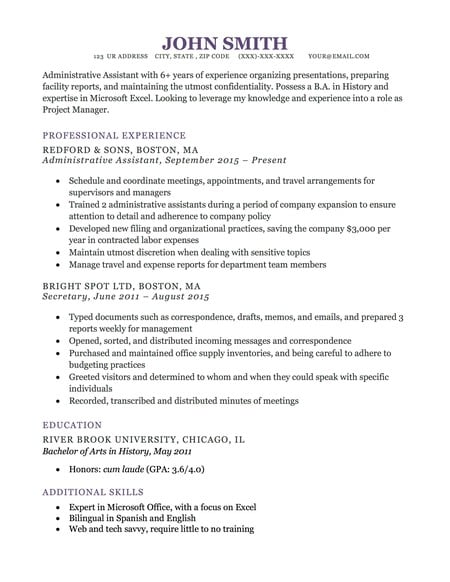
Who might use it? Anyone looking for a traditional chronological resume!
- You don’t need to include your full address (just a city and state will suffice).
- Add your LinkedIn profile alongside your other contact info so that the recruiter or hiring manager can head to your page and find additional information about your experience, see glowing recommendations you’ve received, look at work samples you’ve posted, and get excited about you as a candidate. (Just make sure your profile is updated !)
- Don’t include your GPA unless you’re a recent grad and it’s impressive.
Download it here .
2. JobScan’s Recent Grad 1 Template
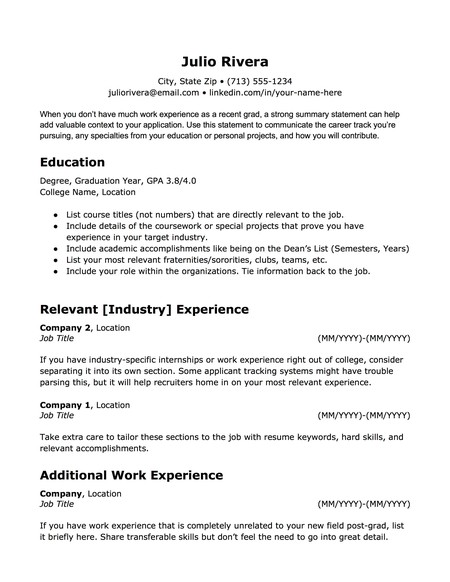
Who might use it? A recent grad who has internship or work experience that’s relevant to their target field or role as well as other experience.
- You don’t need to include your zip code.
3. Microsoft Office’s Basic Resume Template

Who might use it? A recent grad who doesn’t have a ton of work experience.
- Put your name all on one line (instead of two lines, as in the default) to ensure the ATS captures your full name.
- Try to differentiate the section headings from each job and education entry by changing the font size or style.
- Add your LinkedIn profile next to your contact info and remember you don’t have to put your full address (just a city and state will suffice).
Find it in Microsoft Word.
4. Get Landed’s ATS-Friendly Resume Template
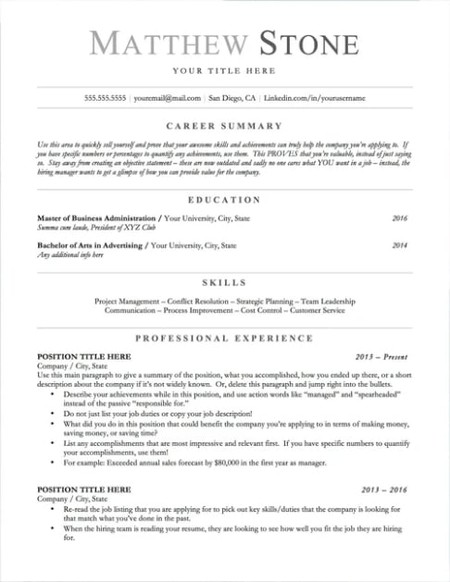
Who might use it? Someone looking for a template that could easily be tweaked as a chronological or combination resume, depending on where you put that skills section.
- Unless you’re a recent grad, you probably shouldn’t have your education up so high.
5. ResumeByRecruiters’ ATS Resume on Etsy
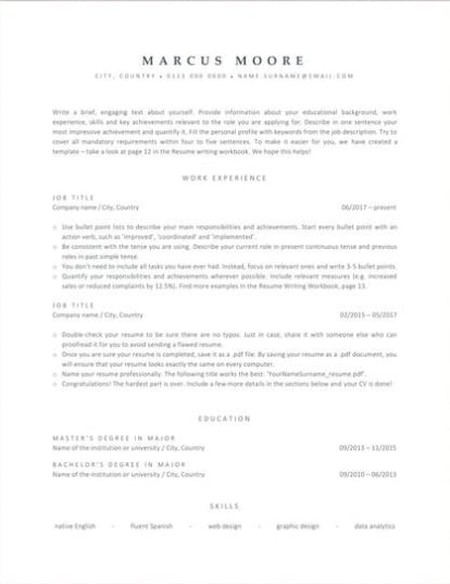
Who might use it? Someone looking for a template that could easily be tweaked as a chronological or combination resume (by moving up the skills section to the top).
- Add your LinkedIn profile alongside your contact info.
Cost: About $12
6. JobScan’s Classic Chronological and Hybrid Templates
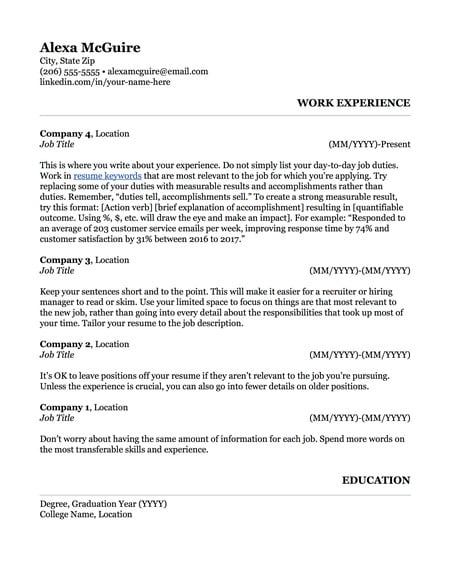
Who might use it? Someone looking for a simple template with no frills.
- Try to make sure you fit everything on one page.
Download them here .
7. Resume Genius’ White House Template
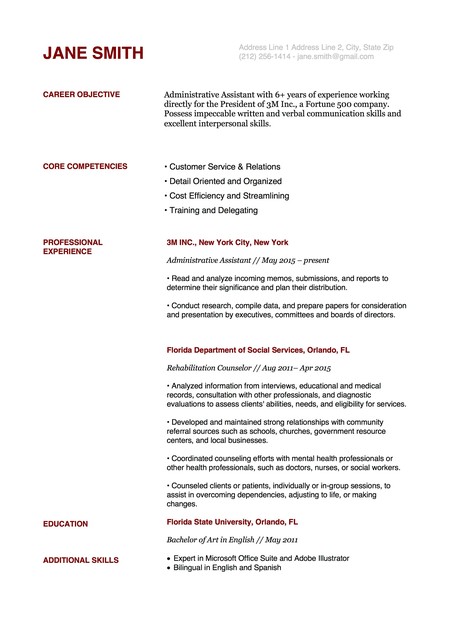
Who might use it? Someone looking for a template with a lot of white space.
- You don’t need a full address; city and state is enough.
- Add your LinkedIn profile.
- Do not use a resume objective section. You can replace that with a summary or get rid of it entirely.
Resume templates
Put your best qualities on display with professional, customizable resume and cv templates. no matter your line of work or length of professional history, you'll find resume and cv templates that'll help you get the gig..
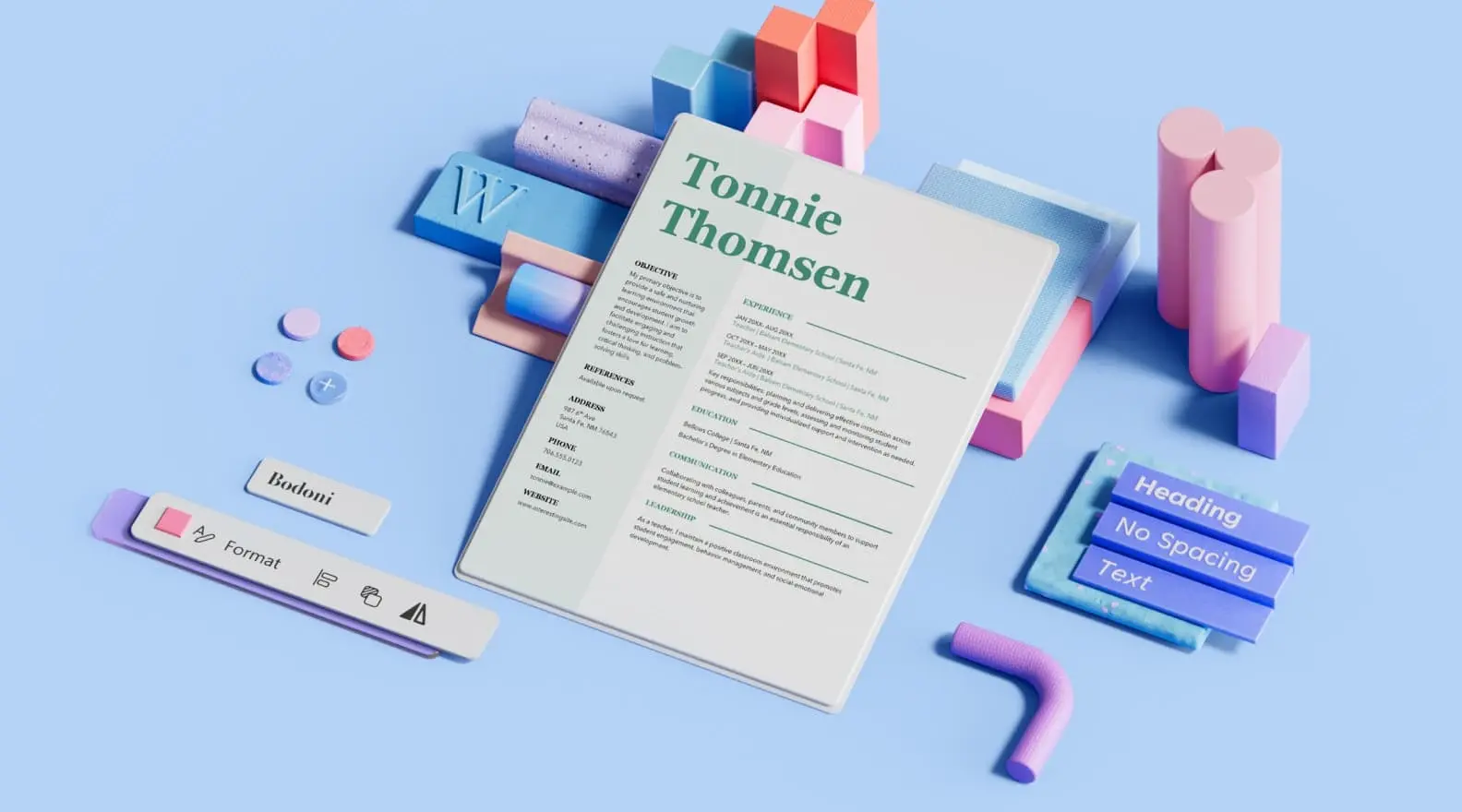
Download free resume templates
Land your dream job with free, customizable resume templates. Showcase your potential to recruiters and stand out from other candidates with a professional template. Whether you're applying to corporate positions or creative roles, go with a sleek design or show your creativity with bold colors .
Resumes don't need to look boring—add flair to your professional experience with a creative resume template. There are plenty of resume designs to choose from, like simple resume templates and modern resume templates. Each resume template is fully customizable in Microsoft Word , so you can personalize each design element and add your own text. Using a template also makes it easier to customize your resume for each position you apply to.
Print out as many copies as you'd like or download the template for free to share digitally when applying online. These professional resume templates are perfect for any stage of life or career. Whether you're a high school student, actor, or seeking a career in nursing, you can find any format for any job type.
There are also a variety of free CV (Curriculum Vitae) templates to choose from. A CV is often longer than a resume and contains an in-depth look at your education and professional accomplishments. Like our resume templates, these CV templates are also customizable in Word.
Remember, your next job is only a template away! Once you've customized your resume, explore free cover letter templates to help you land the job.
How to Create a Professional Resume Using Microsoft Word

Your changes have been saved
Email Is sent
Please verify your email address.
You’ve reached your account maximum for followed topics.
The 6 Most Underrated Photo Editing Effects You Should Be Using
How to optimize your smartphone photos for printing, when does facebook messenger notify others about screenshots.
Microsoft Word offers templates and tools for creating resumes. Whether you are new to the workforce or an experienced professional, you have a variety of options.
Many companies use Application Tracking Software (ATS) which looks for keywords and specific color and design format in your resume. It can be rejected by ATS or a recruiter if the resume is not optimized and lacks standard design.
Sharing your work experience and skills is the first step in getting the attention of a recruiter. Let's understand how to create a professional resume in Microsoft Word.
Why Use a Resume Template?
Designing a resume from scratch and adding suitable content is a time-consuming process. Resume templates in Microsoft Word are created by professional designers and, therefore, in line with industry standards.
Using them can increase your chance of making a good first impression and meeting the required guidelines.
Choosing the Right Template
Now that you have learned the importance of using a template, let's see how to choose the right one. Microsoft provides an array of templates for diverse job profiles. Usually, designers or artists use templates with prominent visual elements.
These elements help in showcasing their portfolios, such as artwork, wireframe designs, or photographs. In contrast, technical or sales professionals prefer a design with a maximum of two colors and a simple layout.
Creating a Resume
Let's see how you can find the right template and create a resume.
- Open Microsoft Word and click New .
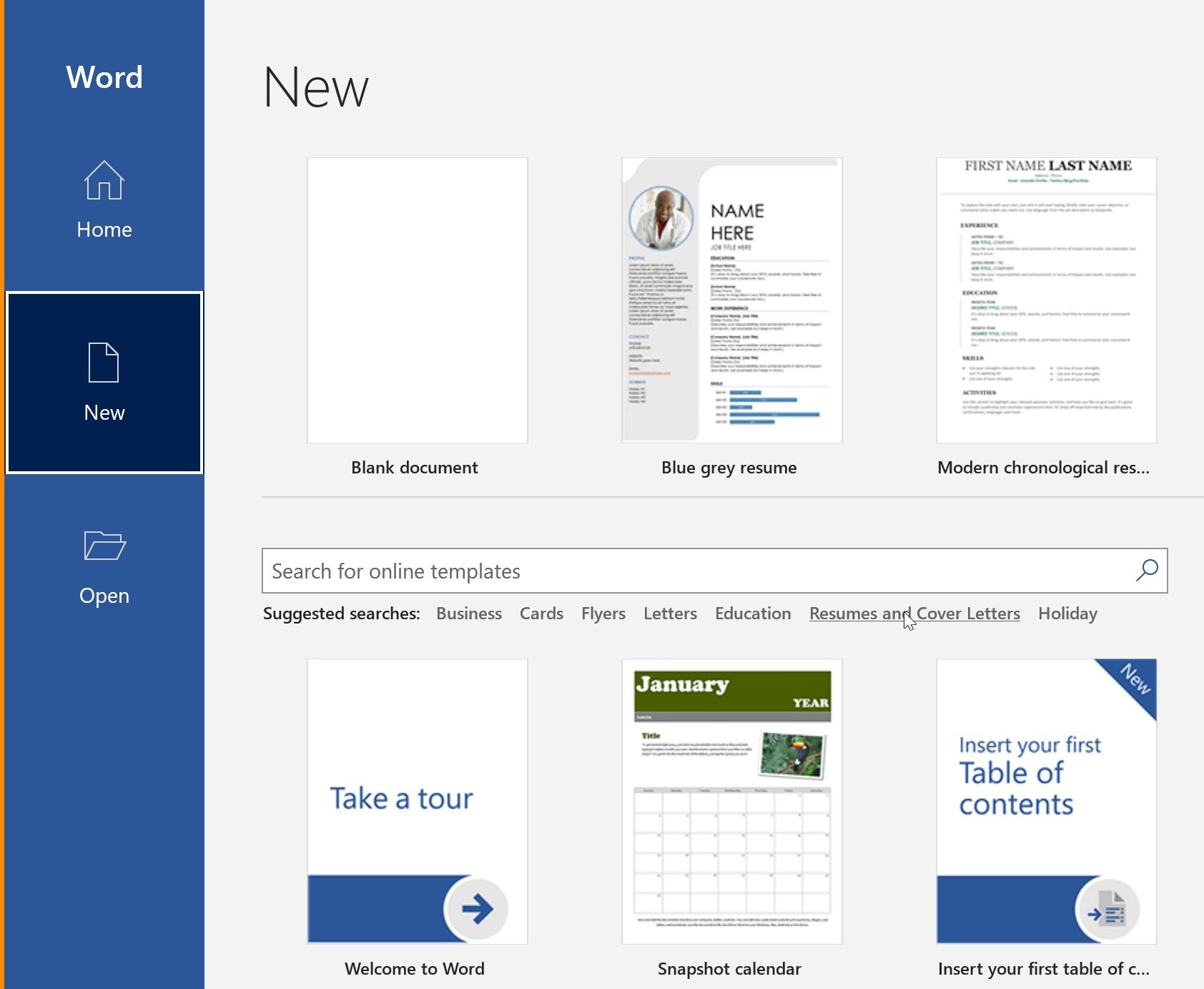
- Browse the list and click the Pin option to mark a few templates for future reference.
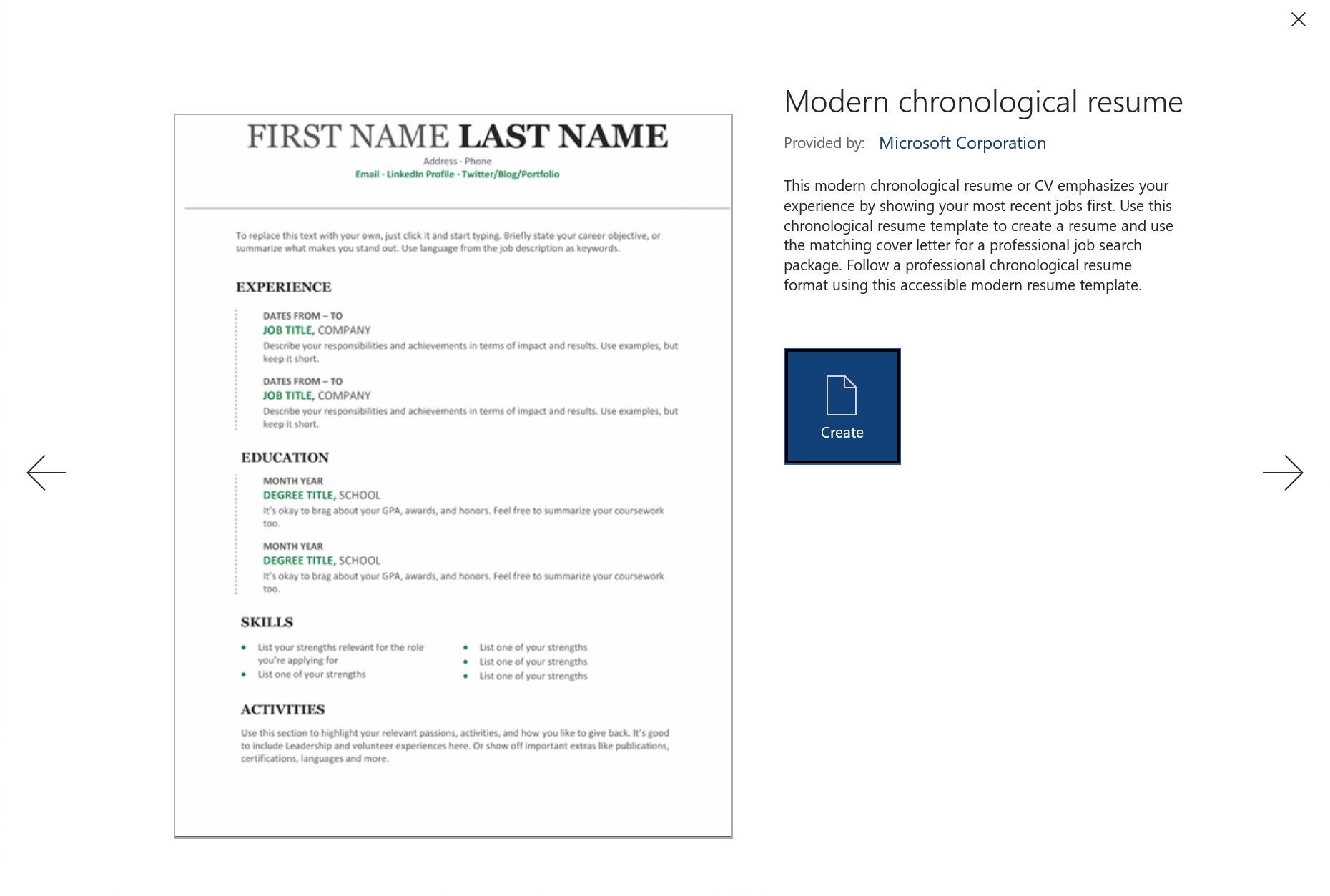
- After you have finalized a template, click Create .
- Remove sections that are not relevant. For example, if you are a graduate, the Experience section may not be relevant.
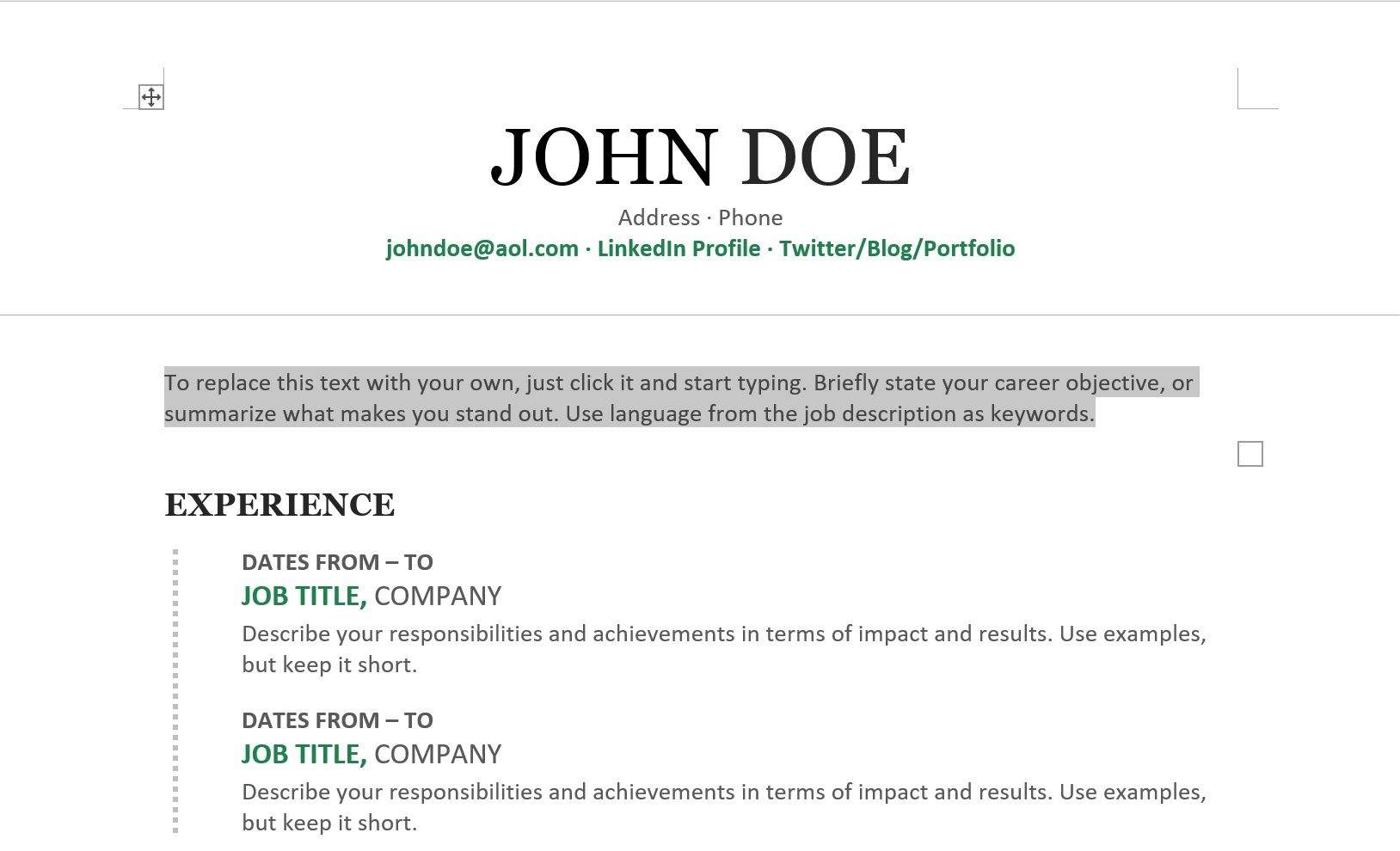
- Click Save .
Using the Resume Assitant by LinkedIn
When you create a resume in Microsoft Word, the Resume Assistant is displayed on the right panel. The assistant shows samples of popular LinkedIn profiles relevant to you.
If you face writer's block or need ideas to enhance your content, follow these steps to use the assistant.
- Enter your LinkedIn login credentials, role, and the preferred industry.
- Click Get Started . Examples of public profiles based on your preferences are displayed.
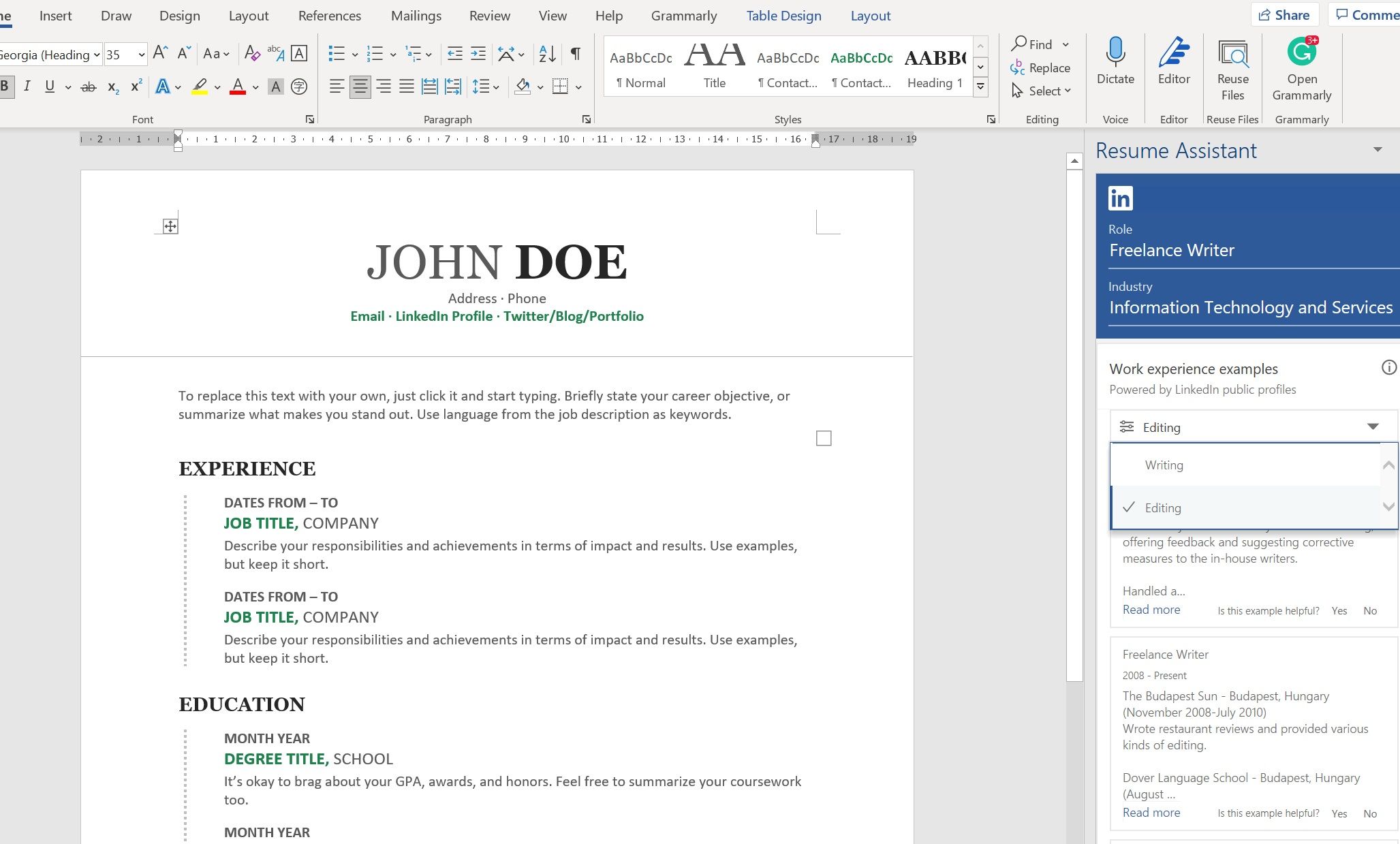
- Click the Read More option to view the details.
Polishing Your Resume
Incorrect grammar creates a poor impression on a recruiter. That's why editing and proofreading the resume is crucial. You can either use the in-built Spelling and Grammar Check feature in Microsoft Word or explore other grammar checkers .
You can also switch to Read Mode or Print Layout to review without distractions. This approach will help you spot errors.

Lastly, print your resume. Reading in paper format highlights spacing issues, missing periods, and incorrect formatting.
Alternative to Microsoft Word 365
Now that you have learned to create a resume in Microsoft Word, you can share it with recruiters or upload it to job portals. If you do not have access to Microsoft Word, alternate web-based software can help you get started.
You can also use external services to align your resume with the job description . These services will ensure that your resume is aligned with your role and meets industry standards.
- Productivity
- Job Searching
How To Make a Resume in Word
There are two different ways to create a resume in Microsoft Word: either by using a resume template or by creating your own resume from scratch. However, as anyone who’s used Word before knows, the program is by no means specifically designed for resume creation and it can therefore be difficult to format and style your resume exactly how you want it.
This article will cover whether or not you should use Word to create your resume, how to make a resume in Word using a template or from scratch, and how to best format your Word resume if you decide to use the program.
Should You Create a Resume in Word?
Creating a resume in Microsoft Word certainly has its pros and cons. On the plus side, it’s free, there are many different templates available both within Word and online for use with Word, and for many years it has been the go-to program for creating your own resume.
Additionally, a Word resume document can be easily edited by a recruiter if you choose to use one, whereas it’s much more difficult to make changes to a PDF or other type of document. And, if you decide to create your own Word resume without using a template, you will enjoy complete creative control - something you don’t necessarily get with a template or a resume builder tool.
However, Word has some drawbacks as well, such as the fact that many of the templates are dated and may produce a rather dull and drab end result, it can be difficult and time-consuming to make changes to a template, and the templates are not necessarily optimized for the current Applicant Tracking Systems ( ATS ) that the vast majority of companies use to filter job applicants.
Microsoft Word has a bit of a learning curve, so even something small like reordering the sections of a template can cause a major headache. Making your own resume from scratch in Word is obviously even more difficult. It not only requires experience using the program, but also some design experience in order to create a resume that is pleasing to look at, well-organized, and formatted properly so that it will pass an ATS scan.
It will also take significantly longer to create your own resume than it will to either use a Word template or to simply enter your details into a resume builder which can be frustrating when you want to begin applying for jobs immediately.
As an alternative to Microsoft Word, Jobseeker offers a resume builder tool with a library of modern, easily customizable resume templates that are ATS-optimized. It’s simple to use and you can be sure that your resume will stand out.
But, if you prefer to stick with Microsoft Word, you can certainly still create a top-notch resume. Here’s how:
How To Use a Microsoft Word Resume Template
First we’ll look at the easier way to use Word for resume creation: using a template.
Step 1: Pick a Template
Start by opening Microsoft Word and searching for ‘resume’ in the top right search bar. You can then select ‘templates’ and pick one that fits your personality, job niche, and style. For example, if you are applying for a corporate accounting job, you will likely want to select a more staid template than if you are applying for a graphic design position or another creative job.
You can also search for free downloadable templates online that are designed to be used with Word, if you don’t like any of the standard options.
Step 2: Create Your Resume Header
Once you’ve picked your favorite template and opened it, you’ll begin by completing your resume header. This contains basic information like your full name, address , email , and phone number. You may also wish to include your current job title, LinkedIn URL, personal or portfolio website URL, and/or social media links in your header if that information is relevant to your profession.
Some Word templates will include these fields, but you may have to add them manually if you’ve chosen a template that does not.
Step 3: Write Your Resume Summary Statement
Next, add your resume summary statement or a resume objective . A resume summary is appropriate for the vast majority of applicants as it sums up your professional experience and personal qualities that make you a good fit for the position. A resume objective is better suited for those who are just entering the professional world (i.e. students or recent graduates) or those who are making a career change.
Your resume summary or objective is a brief snippet just under your resume header that should be written with the goal of attracting and keeping the attention of the hiring manager who is reading it, so they don’t just flip right past your resume.
Step 4: Input Your Work Experience, Education, Skills, and Accomplishments
Finally, it’s time to enter in your work experience , education history, personal skills , and professional accomplishments. While the majority of this is filling in the blanks, you should still make these sections as compelling as possible by highlighting achievements over responsibilities and tailoring your resume to each application.
Reread the job posting that you are applying for and implement some of the key words and phrases that the employer uses - this will help you get through the ATS screening phase and it’ll let the hiring manager know that you paid attention and took the time to customize your resume.
If you don’t have a lot of work experience to highlight, include optional resume sections like languages, volunteering experience, hobbies and interests, etc. This will not only fill out your resume so it doesn’t look empty, but it will also give your potential employer a better understanding of who you are as a well-rounded person.
Remember, your resume should be a single page unless you have more than ten years of experience in your field, in which case it shouldn’t exceed two pages.
How To Create a Resume in Word Without a Template
If you prefer not to use a Word resume template, you can still use the program to create a resume. However, unless you have some design skills and a lot of patience, you’ll likely want to stick with a template or use Jobseeker’s resume builder tool.
Still want to go for it? Be sure to include all of the same sections that we outlined above and clearly label each one with a heading. You can play with the page margins and line spacing in order to fit all of your credentials on a single page, and use page borders, lines, and/or color blocks to spice up your resume and divide it into a clear, easy-to-read layout.
Word has some built-in features that lend themselves to creating an eye-catching resume, such as the column tool which allows you to format your document with one, two, or three columns, or to create a sidebar on the left or right side of the page. A sidebar is a great way to add interest to the page while still reserving the larger main column for the bulk of your information.
You can also change the alignment of the text, although only your header should be centered. Otherwise, stick with left alignment as it’s the easiest to read and the most professional.
Word has a variety of text styles available that can save you time while formatting your resume. They can be used as follows to create a uniform layout:
- Heading 1 (H1): Use H1 for your most important title, which should be your name across the top of your resume. This is the largest text in the document and it will be bold and impactful.
- Heading 2 (H2): Use H2 headings to label the sections of your resume (i.e. Work Experience, Skills, etc.). H2 text will be smaller than H1, but still bold and big enough to stand out.
- Heading 3 (H3): Use H3 headings when you are listing your job titles within your Work Experience section. This should be just barely bigger than normal text, but still bold.
- Normal text: Everything else on your resume should be written using the Normal style, including the bullet points under each job title, your resume summary, and descriptions of your skills. Use 11 or 12 as your Normal font size.
Word has default settings for each of these styles, but you can go in and set your own font, text size, color, and whether each style will be bold and/or italicized. Whatever style you decide to use, be consistent with it throughout your entire resume. This will provide clear organization and a clean look.
Formatting Your Word Resume
Whether you opt to use a resume template or not, here are some formatting items to keep in mind as you create your resume in Word:
Fonts and Colors
Don’t go overboard with fonts or colors in your resume - this is, after all, a business document. Choose a professional, easy-to-read font like one of the following:
- Trebuchet MS
While you can deviate from the classic black text, be sure that your resume will still be readable by using dark, muted colors like navy, dark gray, or forest green.
If you can’t resist a pop of color, consider changing the background color of your header to something that’s not garish (i.e. no hot pink or neon green) and make the header text a contrasting color, like white text on a navy background or black text on a sage green background.
Clear Layout
Keep your Word resume layout fairly simple - include two columns at most and clearly label each section. If your resume looks like a jumbled mess, recruiters and hiring managers won’t take the time to decipher it and you’ll likely be skipped over as a candidate.
Watch for Jumps
Microsoft Word is infamous for its poor ability to handle layout changes (like moving or resizing a photo , adding a line break, etc.), so if you do decide to change a template or create your own layout, make sure that you review it closely when you’re done to ensure that nothing has sneakily moved around.
Spell Check
And, of course, you should thoroughly spell check your resume before you send it off to any potential employers. Nothing screams ‘unprofessional’ like misspelled words on your resume. Word has a built-in spell check feature, but you should never rely completely on that. Always read through your resume, or, if spelling isn’t your strong suit, have a friend or family member double-check it for you.
Saving Your Word Resume
In most cases, you’ll want to save your resume as a PDF as well as a Word document. Most ATSs will read PDFs, and the PDF format will prevent anything from going awry with your careful Word formatting, which can happen if you submit a Word document and the hiring manager has a different edition of the program.
It’s also a good idea to print out a few copies of your resume so that you can see how it will look when your potential employer prints it out to read it, and bring them with you if you score an interview.
Finally, save your resume with a file name like ‘JaneDoeResume’ so it’s immediately clear to the hiring manager what document they are looking at and so there won’t be any confusion in the application process.
Key Takeaways
Microsoft Word can be difficult to use for resume creation, but it can certainly be done with a template or by creating your own resume format. Just remember to keep an eye out for the infamous ‘Word jump’ as you build your document.
If creating a resume in Word is too frustrating, you can produce a polished, professional resume on Jobseeker in just a few steps. Choose from a wide selection of templates, easily change the colors and fonts to fit your tastes, and know that your resume will be ATS-optimized.
Get ahead of the competition
Make your job applications stand-out from other candidates.

How to Show Promotion on Resumes for Best Results

How To Write a Resume in Spanish

Summary of Qualifications for a Resume
Your current User-Agent string appears to be from an automated process, if this is incorrect, please click this link:
- Format a resume with a template Video
- Format using tables Video
- Tools for better resumes Video

Format a resume with a template

Here’s how to download and use a template to create a sharp resume. We’ll show how you can cut and paste parts of your old resume and make the fonts and spacing look perfect.
Whether you’re online or offline go to FILE > New and search for “Resume.”
Preview and click the one you want to open.
You can start typing right away or cut and paste text into the document.
After pasting old text, it might look funny, or not formatted correctly. Select Ctrl to see Paste Options and choose one like Keep Text Only . Then the text use the font and formatting of the new resume.
Six steps to developing a great resume
Microsoft resume templates
Look up words in the thesaurus
Most people submit resumes online these days, but there are still reasons why you need a paper resume.
A big one is at the interview. You want to come in with copies of your resume so you can hand it to the person.
So they don’t have to scramble to find the copy of theirs or look for on their computer.
So I’m going to show you a couple of different ways of formatting a resume.
First of all it’s going to be with a template.
I’m going to open up Word 2013 here, and it opens to this new gallery view that shows off templates.
If you have an earlier version of Word, you just want to go to FILE and New and you’ll be able to search for resume or search for templates.
I’m going to type in “Resume”.
If I was offline I get about a dozen or so resumes, here online I can get the full power of Office.com .
I can get a couple hundred I can look for.
Some with categories, occupations… Let me just click on this thumbnail, I can see a little bigger thumbnail, and I can click through these arrows to find one I like.
You can also see customer ratings which is Ahh..You know that way you can see what’s populate what people like.
I’m going to use this one here called the Timeless design . Open that up. And it populates with my name.
Today I’m Daryl McFarland. And it gives you some instructions of how to use the template if you need that or you can just start typing away with your new objective here for your resume.
Now with resumes, most of the time people have older resume, they may cut and paste in, they want to format it so let’s look at that for a few moments here. I’m going to open up some text that I have here.
And just cut and paste this objective.
And you want to ahh.. make sure you know each resume has to have a different objective for each company.
Don’t want to be general. You want to be specific with your resume.
So, here I have the text that I want but, of course, it looks a little different. The font size is wrong.
There is a couple of different ways to change the formatting. You can look at styles. Some people use Format Painter .
But when you cut and paste, if you don’t touch any other keys, you get this little box here at the end, with a little clipboard that says Ctrl by it.
Ctrl is the shortcut. So let me click Ctrl . And it opens up Paste options. And it gives me several options I can use.
I can use this one called Keep Text Only . And look, it shrinks down my text. Perfect. So that’s good. Let’s do it one more time.
We’re going to grab some of these old skills I have and I’ll update them as I work this new resume. Again, little too big.
Now notice this last line I have some bold text in it.
I want to keep that bold text but if I chose the option -- Keep text only , it strips out all formatting.
So hyperlinks and everything is striped out so I don’t want to use that.
I want to go over here and Merge Formatting , and there, it keeps the bold and also makes the text look proper for this template.
Templates in general especially in resumes, templates have what we call control content.
If you look up here we have boxes for street address, telephone, email.
That just gives you some structure to the template, you can delete those if you want.
Also down here in the experience area we have this.
If you don’t want it, again you can just simply right-click and remove content control and it’ll strip that away.
A lot of times people just want to update a resume with a different look.
You can do that really quickly with the DESIGN tab. Let’s go over there.
So click DESIGN and I get all this formatting options here at the top and I can just mouse over and my resume changes, it previews.
Now some of these look good. Some of them really don’t look good.
But it’s a quick way to kind of get a different look for your resumes.
Because sometimes we just want a fresh start with a new resume. You can also do that with Themes over here on the far left.
Themes are a great way to control color, font size, spacing.
I use it a lot for PowerPoint and not as much in Word, but you can set a difference to your resume and just click the one that you want. So that’s working with templates.
In our next video, we’re going to use formatting, well, we’re going to format without a template.

Need more help?
Want more options.
Explore subscription benefits, browse training courses, learn how to secure your device, and more.

Microsoft 365 subscription benefits

Microsoft 365 training

Microsoft security

Accessibility center
Communities help you ask and answer questions, give feedback, and hear from experts with rich knowledge.

Ask the Microsoft Community

Microsoft Tech Community

Windows Insiders
Microsoft 365 Insiders
Was this information helpful?
Thank you for your feedback.

Microsoft Copilot
Microsoft copilot is your everyday ai companion that helps you to be smarter, more productive, more creative, and more connected to the people and things around you. whether you want to learn how to code, plan an influencer level vacation, or just need a little help writing a hard email, your everyday ai companion is there to help you get the job done like a pro. if you missed that meeting and need a quick recap or can’t figure out the tax code for your new side hustle, copilot is there to sprinkle some ai pixie dust on the problem. there when you need it, copilot works smoothly, seamlessly, and securely across your microsoft apps to elevate everything you do. speed up tasks, get more personalized answers and useful information, or find new creative inspiration. and you can do it all by asking for what you want the way you naturally write and speak. it doesn’t care if the task is big or small, it’s just there to help you get the job done. copilot empowers you to achieve anything you can imagine., 4/25/2024 3:53:49 am.
- Career Centers Across UMass
- Our Newton Campus
- Handshake Login
- Student Outcomes
- Undergraduates
- Identity-Based Resources
- International Students
- Prospective Students
- UWW Students
- Post Jobs and Internships
- Host an Event
- Career Fairs at UMass
- Why Recruit at UMass
- Internship Program Best Practices
- Recruiting Guidelines
- Resource Library
- Self Discovery and Career Exploration
- Build Career Skills: Resumes, Job-searching, and Interviewing
- Learn Additional Technical, Creative, and Professional Skills
- Your Career Support Team
- Gain Experience: Internships, Co-ops, Research, and More!
- Is Graduate School Right for Me?
- Year-by-Year Checklist
- Cover Letters
- Career Fair Preparation
- Interviewing
- LinkedIn Learning
- What Skills Do Employers Want?
- Applying to Grad School
- Arts, Multimedia, and Entertainment
- Business, Financial Services, and Consulting
- Data and Information Technology
- Education, Human Services, and Counseling
- Energy, Environment, and Agriculture
- Engineering
- Government and Public Service
- Healthcare and Life Sciences
- Infrastructure and Transportation
- Law and Legal Services Career Community
- Bachelor's Degree with Individual Concentration (BDIC)
- Graduate School Office of Professional Development
- Humanities & Fine Arts (HFA)
- Information & Computer Sciences (CICS)
- Isenberg School of Management (ISOM)
- Natural Sciences (CNS)
- Public Health and Health Sciences (SPHHS)
- Social & Behavioral Sciences (SBS)
- University Without Walls (UWW)
- Connect with UMass Alumni
- Using LinkedIn
- How to Network
- Field Experience Definitions
- Internships
- Civic Engagement and Service Learning
- Internships and Co-Ops at Mount Ida
- UMass Internship Partner Programs
- Scholarships for Field Experiences
- Searching for Jobs & Internships
- Can I Do an Internship?
- Negotiating Job Offers
- Using Handshake
Resume Writing Guide
A resume is typically an employer’s first introduction to you. First impressions are crucial to establish yourself as professional, capable, and motivated. A strong resume demonstrates your transferrable skills, communication abilities, and achievements. A consistent, detailed, and concise resume can help your resume get noticed by recruiters. By formatting your resume professionally, you increase your chances of earning the interview.
Resume Components
Contact information, phone number.
Use a phone number you can answer readily, such as your cell phone. If you have a voice mail set-up, make sure it sounds professional with your name and the best times to contact you.
Your e-mail address should be professional. While you are enrolled at UMass Amherst, your UMass e-mail will work well. After graduation, consider creating a new e-mail address that contains your name.
Always include phone and email, but consider if listing your address is helpful or harmful. Employers may give preference to people who are closer geographically - if you are applying from far away, they may be unsure whether you are serious about moving.
Additionally, while your city and state are helpful to list, you do not necessarily need to include your street address. Employers will need it to hire you, but it is not required to provide during the job application process.
Objective/Summary
This section is most useful when you hand your paper resume out at a career or networking event - unless you have something specific to highlight, consider leaving it off your resume. A cover letter will do a better job conveying your why, as well as your key abilities. When you submit electronically, many Applicant Tracking Systems (ATS) will often skip the summary section and look for those key words to be in the body of your document instead.
For currently enrolled students, you will list your current degree first, and then work backwards in reverse chronological order. During your first few years of college, consider including your high school until you run out of space.
In addition to your college education, you may also highlight study abroad or domestic exchange programs . When discussing these programs, think about including the following experiences to highlight your transferable skills:
Class projects
Volunteering/internships/research applicable to your field
Independent travel
Learning to work with a more diverse group of people than you had previously been exposed to
Resolving conflicts based on misunderstandings of cultural differences
Learn new activities, languages, hobbies, or skills
Education Section Example
University of Massachusetts, Amherst (Fall 2024 - Present)
Bachelor of Arts, Major: English
GPA (if over 3.0 and you feel comfortable sharing)
Relevant Coursework: 3-5 courses max
Awards (when including awards, include the reason for receiving it. Example: "21st Century Leadership Award for high academic achievement in first year")
Senior Project: (optional)
Portfolio of work (optional)
There are many types of experiences: volunteer, paid, unpaid, work study. If the experience is relevant and taught you transferrable skills, find a way to include it.
- For each experience, include name of organization, your title or role, location, and dates
- Action verbs (samples below) to help you write accomplishment statements, which prove you have the skills you say by leaning into outcomes and successes
- Consider using multiple experience headings, such as: research experience, industry experience, or relevant experience. This can be a good way to move more relevant experiences up higher on your resume, even if they happened further in the past.
- Quantifying your work can demonstrate your aptitude. Answering questions such as "How many?", "How much?", and "How often?" will help recruiters understand the extent of your skills.
- Avoid “responsibilities included" and writing in a passive voice - using action verbs will make this easier.
Experience Example
Leverage, Incorporated: Boston, MA (September 2025 - Present)
Computer Science Intern
- Developed an algorithm that identified patterns in white collar crime in the financial industries across the United States. Implementation of this program reduced company losses by 17% compared to the previous quarter.
- Collaborated with supply chain division to design new packaging based on reduction of carbon footprint, leading to increased production distribution while reducing energy usage.
- Established a training program to help connect interns with mentors at the organization and was awarded the Innovative Intern of Quarter for these efforts
This section is typically for "hard" skills, which are skills that can easily be measured. Soft skills (such as interpersonal skills) are better described in bullet points of your experience section so they can have the context they require. For a skills section, depending on your targeted field, you may add computer, language, laboratory skills, or performances. For languages, put your level of fluency (e.g., proficient, advanced, fluent, native).
Skills Example
Computer: Microsoft Office (Word, Excel), Adobe Suite (Photoshop, InDesign), Data Analysis (R-Studio, SPSS)
Resume Formatting and Layout
The average reading only spends 20 seconds reading a resume. Before that, an applicant tracking system may be utilized to select which resumes get reviewed by a human being. Make sure your resume is easy to read and stands out.
No single format works for everyone: the only rule is that you need to be honest, factual, and relevant
One page is ideal (especially for internships) and for students ages 18-25
Keep a longer master resume for future opportunities
List everything in reserve chronological order; start with your most recent experience work backwards
Use a legible sans serif font size, keep it readable, 11 is a good place to start
1 column is better than 2; when you have two columns the reader may jump around and miss key information
No icons or images as they cannot be read by applicant tracking software
How Many Resume Versions Do I Need?
There is a big difference between customizing your resume for a specific position/industry versus creating different documents for each application.
- If you are applying to jobs in drastically different industries, you will want to customize resumes for each industry. For example, a psychology major applying to jobs in Human Services as well as Human Resources will want to highlight different experiences and skills for each, and potentially format their resumes different as a business setting holds different expectations for job criteria compared to a mental health setting.
- If you're pursuing a few different roles, but they're all related to one discipline or field, then you will not need multiple versions of your resume. However, you will still want to tweak each resume you send out based on the specific job description.
Specialized Resumes/Sections
While resumes may follow the same general format, depending on your experience and industry, there may be other considerations to help your resume stand out.
Design Resumes
Design resumes can differ from traditional resumes in several tangible ways, reflecting the unique skills and creative nature of design professions.
Your document is an indication of your style aesthetic and may not need to conform to the same rules and standards as other professions.
Visual Layout
Design resumes often incorporate creative layouts that display the designer's skills in typography, layout, and visual communication.
- Infographics: Use of icons, graphs, and other visual elements can represent skills, experience, and achievements.
- Color and Typography: Thoughtful use of color and font choices creates an aesthetically pleasing document that aligns with your personal brand.
Content Presentation and Customization
Direct links to online portfolios or examples of work, are often included as part of the resume. Incorporation of personal logos, custom icons, and other branding elements that reflect a designer's style may be added here.
File Format and Compatibility
Designers create their resumes in online spaces varying from Latec to Adobe to Canva. While many resumes are shared as PDFs, design resumes especially should be shared in this format to preserve visual integrity across different devices.
Unique Layouts
Non-traditional formats such as infographics, timelines, or modular layouts may be acceptable.
Interactivity
For digital resumes, elements of interactivity can be incorporated, such as clickable links, hover effects, and embedded multimedia.
The most important rules still apply to ALL resumes; clean neat formatting, with consistency in where the reader will access key information continues to be your driving force.
Designers should contact their career centers to discuss what resume style might best suit their professional goals.
Digital Resumes
A digital resume is an electronic version of a traditional resume that highlights an individual's professional experience, skills, and achievements using digital formats.
Either shared as a PDF or hosted on a personal website, this format allows for enhanced interactivity and multimedia integration. Digital resumes often feature creative layouts, embedded links to portfolios, and interactive elements such as hover effects or animations.
They enable candidates to visually demonstrate their technical and design skills, making them particularly popular in creative and tech industries. The goal of a digital resume is to highlight qualifications, but also provide a dynamic and engaging avenue for potential employers to assess a candidate’s capabilities.
Student Athletes
As a UMass athlete, you learn incredible transferable skills in areas such as communication, leadership, and teamwork. You also spend more time at your activity than most, so make sure they see all your greatness in action.
“Effectively managed communications between 24 team members, served as liaison connecting team and coaching staff, and effectively resolved intra-group conflicts.”
“Excellent time management skills. Balanced a 30+ hour practice, training, competition, and travel schedule while balancing full academic course load.
How to Insert a Line in Word for Resume: A Step-by-Step Guide
how to insert a line in word for resume
Adding a line to your resume in Microsoft Word is a simple task that can make your document look more professional and organized. By following a few quick steps, you can insert a horizontal line to separate sections, making your resume easier to read. Here’s a step-by-step guide to help you through the process.
Step-by-Step Tutorial on How to Insert a Line in Word for Resume
In this section, you’ll get a detailed walkthrough on how to insert a line in your resume using Microsoft Word. These steps will help you add a neat and professional touch to your document.
Step 1: Open Your Resume Document
First, open the resume document in Microsoft Word where you want to insert the line.
It’s important to have your document ready so you can easily find the section where you’d like to add the line.
Step 2: Place Your Cursor
Place your cursor where you want to insert the line in the document.
Positioning the cursor correctly will ensure that the line appears exactly where you need it.
Step 3: Go to the Insert Tab
Click on the "Insert" tab on the Ribbon at the top of the screen.
The Insert tab contains various options, including the option to add shapes and lines.
Step 4: Click on the Shapes Drop-Down Menu
In the Insert tab, click on the "Shapes" drop-down menu.
This menu will display a variety of shapes, including lines, rectangles, and other geometric figures.
Step 5: Select the Line Tool
From the Shapes drop-down menu, select the straight line tool.
Choosing the straight line tool will allow you to draw a horizontal line across your document.
Step 6: Draw the Line
Click and drag your mouse from the starting point to the ending point to draw the line.
Release the mouse button to complete the line. You can adjust the length and position as needed.
Step 7: Format the Line
Right-click on the line and select "Format Shape" to customize the line’s appearance.
You can change the color, thickness, and style of the line to match the overall look of your resume.
After completing these steps, you’ll have a neatly inserted line in your resume. This line can help to visually separate different sections, making your document more organized and professional.
Tips for Inserting a Line in Word for Resume
- Always save your document before making changes to avoid losing any work.
- Use consistent line formatting throughout your resume for a cohesive look.
- Consider using lines to separate major sections like Work Experience, Education, and Skills.
- Experiment with different line styles to see which one best fits your resume’s design.
- Remember to preview your resume before finalizing to make sure everything looks perfect.
Frequently Asked Questions
How do i remove a line in word.
To remove a line, simply click on it and press the "Delete" key on your keyboard.
Can I change the color of the line?
Yes, you can change the color of the line by right-clicking on it and selecting "Format Shape," then choosing your desired color.
What if I accidentally insert the line in the wrong place?
You can click and drag the line to reposition it, or you can delete it and insert a new one in the correct location.
Can I add a line using keyboard shortcuts?
No, there are no specific keyboard shortcuts for inserting a line, but the process is quick and easy using the Insert tab.
Will the line affect text formatting?
No, the line acts as a separate element and will not disrupt your text formatting.
Summary of How to Insert a Line in Word for Resume
- Open your resume document.
- Place your cursor where you want the line.
- Go to the Insert tab.
- Click on the Shapes drop-down menu.
- Select the line tool.
- Draw the line.
- Format the line.
Inserting a line in Word for your resume is a straightforward process that can significantly enhance the visual appeal of your document. By following the simple steps outlined above, you can add a professional touch that makes your resume stand out. Remember, small details like these can make a big difference in how your resume is perceived by potential employers.
Taking a little extra time to format your resume properly shows attention to detail and a commitment to presenting yourself in the best possible light. So, go ahead and give it a try. Your resume will not only look better but will also be easier to read. For more tips on creating a standout resume, be sure to explore additional resources or tutorials. Happy job hunting!

Kermit Matthews is a freelance writer based in Philadelphia, Pennsylvania with more than a decade of experience writing technology guides. He has a Bachelor’s and Master’s degree in Computer Science and has spent much of his professional career in IT management.
He specializes in writing content about iPhones, Android devices, Microsoft Office, and many other popular applications and devices.
Read his full bio here .
Share this:
- Click to share on Twitter (Opens in new window)
- Click to share on Facebook (Opens in new window)
- Click to email a link to a friend (Opens in new window)
- Click to share on LinkedIn (Opens in new window)
- Click to share on Reddit (Opens in new window)
- Click to share on Pinterest (Opens in new window)
- Click to share on Tumblr (Opens in new window)
Related posts:
- How to Curve Text in Word for Office 365
- How to Add Horizontal Line in Word for Resume: A Step-by-Step Guide
- How to Make a Box in Microsoft Word: A Step-by-Step Guide
- How to Add Line Numbers in Microsoft Word: A Step-by-Step Guide
- How to Insert Shapes in Google Sheets: A Step-by-Step Guide
- How to Draw on Microsoft Word: A Step-by-Step Guide for Beginners
- How to Add Lines Between Columns in Word 2013
- How to Get a Microsoft Word Character Count in Word 2016, 2019, or Word for Office 365
- How to Download a Microsoft Word Document on Mac: A Step-by-Step Guide
- How to Draw a Line in Word: A Step-by-Step Tutorial
- How to Use Microsoft Word 2007: A Comprehensive Guide
- How to Add a Horizontal Line in Word 2013
- How to Remove Section Breaks in Word Documents
- How to Add a Page on Google Docs
- How to Add a Background in Google Docs (An Easy 6 Step Guide)
- How to Use Microsoft Word: A Comprehensive Guide for Beginners
- How to Add Last Name and Page Number in Word
- Microsoft Word for Mac: Step-by-Step Download & Install Guide
- How to Open a PDF in Microsoft Word: A Step-by-Step Guide
- How to insert shapes in Google Docs: A step-by-step guide
Election latest: Starmer avoids weighing in on US election - as minister admits 'none of' polls look good for Sunak
Sir Keir Starmer has distanced himself from a Labour colleague's previous criticism of Donald Trump, after a good night at a TV debate for the former US president. Earlier, the education secretary admitted to Sky News "none of" the polls were looking good for the Tories.
Friday 28 June 2024 09:57, UK
- General Election 2024
Please use Chrome browser for a more accessible video player
- No polls showing 'best' outcome for Conservatives
- Analysis : Sunak's tetchiness over betting scandal speaks volumes
- Rylan would 'love' to get into politics
- How will Britain's ethnically diverse communities vote?
- Starmer defends plan for VAT on private schools
- Politics at Jack and Sam's : The last weekend
Election essentials
- Manifesto pledges: Conservatives | Greens | Labour | Lib Dems | Plaid | Reform | SNP
- Trackers: Who's leading polls? | Is PM keeping promises?
- Campaign Heritage: Memorable moments from elections gone by
- Follow Sky's politics podcasts: Electoral Dysfunction | Politics At Jack And Sam's
- Read more: Who is standing down? | Key seats to watch | What counts as voter ID? | Check if your constituency is changing | Guide to election lingo
- How to watch election on Sky News
Labour leader Sir Keir Starmer is wrapping up his interview on BBC radio with callers.
He clashes with one caller - Jane -about access to women's spaces.
The caller pushes Sir Keir on whether biological men will be allowed access to women's spaces if he becomes prime minister.
The Labour leader is repeatedly cut off by the caller when he references his past work on violence against women and girls.
Jane says that 51% of the population need to be listened to, rather than a small number of biological men.
The Labour leader says he does not want to allow a "toxic" discussion to take place - and people who do not identify as their birth gender are often "traumatised".
He does not commit to saying that biological men will not be allowed access to women's spaces - but says he will protect women.
Sir Keir Starmer is asked on the BBC about Nigel Farage - and it is put to him whether the Reform UK leader is racist.
The Labour leader says he doesn't want "call him names".
He does say, however, that comments which have come from Reform UK campaigners are racist, and condemns them.
You can read more about that below:
Speaking on BBC radio, Sir Keir Starmer is asked about the tax-free lump sums people can take from their pensions.
According to Hargreaves Lansdown, "this applies to the tax-free element of certain lump sums, capped at £268,275 - amounts exceeding this allowance are taxed at your marginal rate".
Sir Keir says: "It runs out in a number of years, and we're not going to renew it."
He then says, however, that Labour would review the plans in two or three years when they come up for renewal.
This, Sir Keir says, is not something he can promise now due to the economic conditions.
Labour leader Sir Keir Starmer is speaking on BBC radio to callers.
But the interview begins with questions about the debate in the US overnight - for which Joe Biden has been criticised.
Sir Keir says he has "enough on his plate" with his own election campaign.
But he says he will work with "whoever is president".
The Labour leader praises the "historic" nature of the relationship between the UK and the US.
And he says he doesn't think it would be "helpful" to comment on the contest on the other side of the pond.
Asked about previous comments shadow foreign secretary David Lammy made about Donald Trump - which were extremely critical - Sir Keir distances himself from the remarks.
SNP leader John Swinney is speaking to broadcasters this morning.
As a member of the Scottish parliament, he is not standing for election this month.
He has implored voters in Scotland to support his party to face up to what he says is an inevitable Labour win.
Exclusive polling for Sky News carried out by YouGov shows Labour is currently on 35% in Scotland, compared to 29% for the SNP - a slight narrowing in the gap ( read more here ).
Mr Swinney says: "I think the election essentially has been decided in England.
"The Labour Party has a commanding lead over the Conservatives south of the border, and it's a certainty that Keir Starmer is going to become the next prime minister.
"But in Scotland, there's a hotly contested election between the SNP and the Labour Party.
"If they want to make sure that decisions about Scotland are made in Scotland for Scotland, then they've got to vote for the SNP because it's only SNP votes and SNP voices in the House of Commons that will hold the Labour government to account, given that they're going to win hands down in England."
Shadow chief secretary to the Treasury Darren Jones is out for Labour this morning.
Speaking to Sky News, he is asked about Labour's financial plans - especially with the tax burden at a 70-year-high.
Mr Jones says that, if his party wins, they will "inherit the county as it is - not as we might like it".
The situation on tax thresholds is put to the Labour man.
By keeping the levels at which people go up income tax bands frozen, more and more people end up paying higher taxes as wages naturally increase.
This effect has been dubbed a "stealth tax rise", and has led to greater proportions of people paying higher income tax rates than previously.
Mr Jones says: "We would like to unfreeze them, but of course we have to be able to afford to do so.
"And we've not done that at this point in the election because the money's not available right now to be able to do that.
"And that's why when you point to the Conservative Party's promise to change thresholds for certain voters, it's very clear that that's not a promise that anyone can believe, because the money's not there to pay for that commitment"
Sky News' deputy political editor Sam Coates and Politico's Jack Blanchard are here with their guide to the election day ahead.
This is day 39 of the campaign.
Jack and Sam talk about the leaders' final weekend, they discuss how Reform are continuing to be in the headlines, and following the Trump vs Biden debate, they look at the rest of the world, including the upcoming French election.
Email Jack and Sam: [email protected]
👉 Tap here to follow Politics at Jack and Sam's wherever you get your podcasts 👈
Speaking to Sky News this morning, Education Secretary Gillian Keegan has defended people gambling - as long as they do not rely on insider information.
This comes as the election betting scandal in the Conservative Party rumbles on.
Speaking to Sky News, Ms Keegan says: "I do not place bets on anything, least of all politics."
She adds that she doesn't know if "most MPs" are gamblers - adding that "clearly some will be".
"Betting is part of what many people do - and if you're placing a bet on an unknown outcome then, you know, that's something that people do all day, every day.
"But obviously where it's a problem is if you're placing bets on inside information."
Education Secretary Gillian Keegan is giving a frank summation of her party's situation in the election.
The Conservatives have remained around 20 points behind at Labour, and in some polls have fallen behind Reform.
Speaking to Sky News, Ms Keegan says the election campaign is "still going" and they are "still fighting for every vote".
"But clearly, you know, if you look at the 100 or so polls that have been done since the election was called - I think is by far the most polls that we've ever had done - then you've obviously got, a whole range of different views and none of them, looking like the, you know, the best outcome for our party."
The minister, says however, there are a large number of people who previously voted Tory that no longer want to do so.
She says: "So what we're trying to do is make sure we get round to as many of those voters as possible."
There was 0.7% growth in the UK's GDP between January and March this year, the Office for National Statistics as said.
The ONS previously estimated the expansion was 0.6% for this period.
But it has now confirmed they previously underestimated.
These figures came on the back of a short technical recession last year - which means two quarters of contraction in GDP.
The improvement in growth was driven by the services sector, with slightly stronger activity in the professional services, transport and storage sectors.
Be the first to get Breaking News
Install the Sky News app for free


IMAGES
VIDEO
COMMENTS
Learn how to make a resume in Microsoft Word from scratch or from a template. Follow the step-by-step guide to format your resume, add sections, and customize your base format.
Learn how to use Word's templates, formatting tools, and tips to make a résumé that stands out. Find out what information to include, how to organize it, and how to customize it for different jobs.
Learn how to use Word templates to create a resume, and how to format and customize it for different jobs. Find out the pros and cons of using Word as a resume builder, and explore online alternatives.
Learn how to start your resume with a professionally designed template and cover letter in Word. Find out how to access and customize the templates for Windows, macOS and web.
1 Open Microsoft Word. 2 Go to the search bar and type "resume.". Pick one of the pre-formatted resume templates that pop up. 3 Edit the filler text on the resume template with your professional information. 4 Save your document as a PDF and send it via email or submit it to an online job application form.
Start by selecting "New" from the File menu. This displays the New Document task pane. You should then select "My Computer" from the Templates section on the left side of the task pane. Click on the "Other Documents" tab, and then select "Resume Wizard.".
Learn how to choose a template, write a summary, list your work experience, education, skills, and more in Word. See resume examples for different industries and get tips for formatting and adjusting your resume.
Add a Resume Objective/Summary. Double space from the last line in your resume header. Write "Objective" or "Summary" depending on which one you're using. As it's a section title, make it a little larger than the rest of the text (14-16 pt). Also, depending on the font you're using, make it bold.
Whether you're online or offline go to FILE > New and search for "Resume.". Preview and click the one you want to open. You can start typing right away or cut and paste text into the document. After pasting old text, it might look funny, or not formatted correctly. Select Ctrl to see Paste Options and choose one like Keep Text Only.
In this step-by-step tutorial, learn how to create a professional and eye-catching resume in Microsoft Word. In this video, I show you how to make a resume i...
A simple online search about creating a resume from scratch returns millions of results. Choosing the right set of instructions can be daunting. So, instead of going down that rabbit hole, follow this step-by-step guide on creating a resume using MS Word. MS Word resume templates. It can seem like an easy answer to pick a template offered by Word.
How to select a Microsoft Word resume template. Here's how to select a resume template in Microsoft Word: 1. Open Microsoft Word and click on "File" in the top left corner of the screen. 2. Click on "New" from the menu options. 3. In the search bar at the top of the screen, type in "resume". 4.
1. Start with a header. This element can list your contact information, including your first and last name, email address and phone number. Depending on the template you select, this information is often bold and centered at the top of your resume. Simply add your information to the template by clicking each line and typing the required contact ...
To effectively set up Microsoft Word for resume creation, follow these 5 steps: Open Microsoft Word and click on the "File" tab. Select "New" to open the template options. Type "resume" in the search bar to access various resume templates. Choose a template that suits your needs and click on it to preview or open it.
Learn how to create a resume in Microsoft Word from scratch with this simple tutorial. Watch the video and get tips on formatting, design and content.
Here's everything you need to know about finding, picking, and using Microsoft Word resume templates—plus a few examples of templates you can use for free (or cheap!). How to Find Word Resume Templates; How to Choose the Right Word Resume Template; How to Use a Template to Make a Resume in Word; 7 Microsoft Word Templates to Use as Starting ...
Learn how to easily create or customize a resume or CV with the help of Microsoft Word. Especially powerful is the Resume Assistant that is part of Microsoft...
Download free resume templates. Land your dream job with free, customizable resume templates. Showcase your potential to recruiters and stand out from other candidates with a professional template. Whether you're applying to corporate positions or creative roles, go with a sleek design or show your creativity with bold colors.
Open Microsoft Word and click New . Under the search bar, click Resumes and Cover Letter. Alternatively, you can enter Resumes in the search bar. The templates are displayed. Browse the list and click the Pin option to mark a few templates for future reference. Click a template to preview it.
Step 2: Choose a Word resume template. When you open Word, you'll find suggested resume templates. The first suggestions are just a few of the available options in Word. If you search for "Word resume templates," you'll find many more available to use.
Step 1: Pick a Template. Start by opening Microsoft Word and searching for 'resume' in the top right search bar. You can then select 'templates' and pick one that fits your personality, job niche, and style. For example, if you are applying for a corporate accounting job, you will likely want to select a more staid template than if you ...
Add your personal info to the résumé. On the Home tab, select New Items > More Items > Choose Form. Set Look in to User Templates in File System. Locate and select the template you created earlier, then choose Open. Customize the template with content about yourself. Add recipients to the message, then select Send.
Time savings: Create a professional-looking resume in minutes, rather than spending hours formatting and writing it from scratch.; Professional content: Make your resume look polished and professional with suggested content.; Customizable options: Easily modify the content and format of your resume to fit your needs and showcase your skills.; Useful guidance: Get suggestions on what to include ...
Whether you're online or offline go to FILE > New and search for "Resume.". Preview and click the one you want to open. You can start typing right away or cut and paste text into the document. After pasting old text, it might look funny, or not formatted correctly. Select Ctrl to see Paste Options and choose one like Keep Text Only.
Microsoft Copilot is your everyday AI companion that helps you to be smarter, more productive, more creative, and more connected to the people and things around you. Whether you want to learn how to code, plan an Influencer level vacation, or just need a little help writing a hard email, your everyday AI companion is there to help you get the job done like a pro. If you missed that meeting and ...
A resume is typically an employer's first introduction to you. First impressions are crucial to establish yourself as professional, capable, and motivated. A strong resume demonstrates your transferrable skills, communication abilities, and achievements. A consistent, detailed, and concise resume can help your resume get noticed by recruiters.
In this section, you'll get a detailed walkthrough on how to insert a line in your resume using Microsoft Word. These steps will help you add a neat and professional touch to your document. Step 1: Open Your Resume Document. First, open the resume document in Microsoft Word where you want to insert the line.
The star of Love Actually and Paddington 2 (an excuse to share one of the all-time great Sky News articles) described Ms Denyer as a "politician with integrity" in quotes which have been included ...